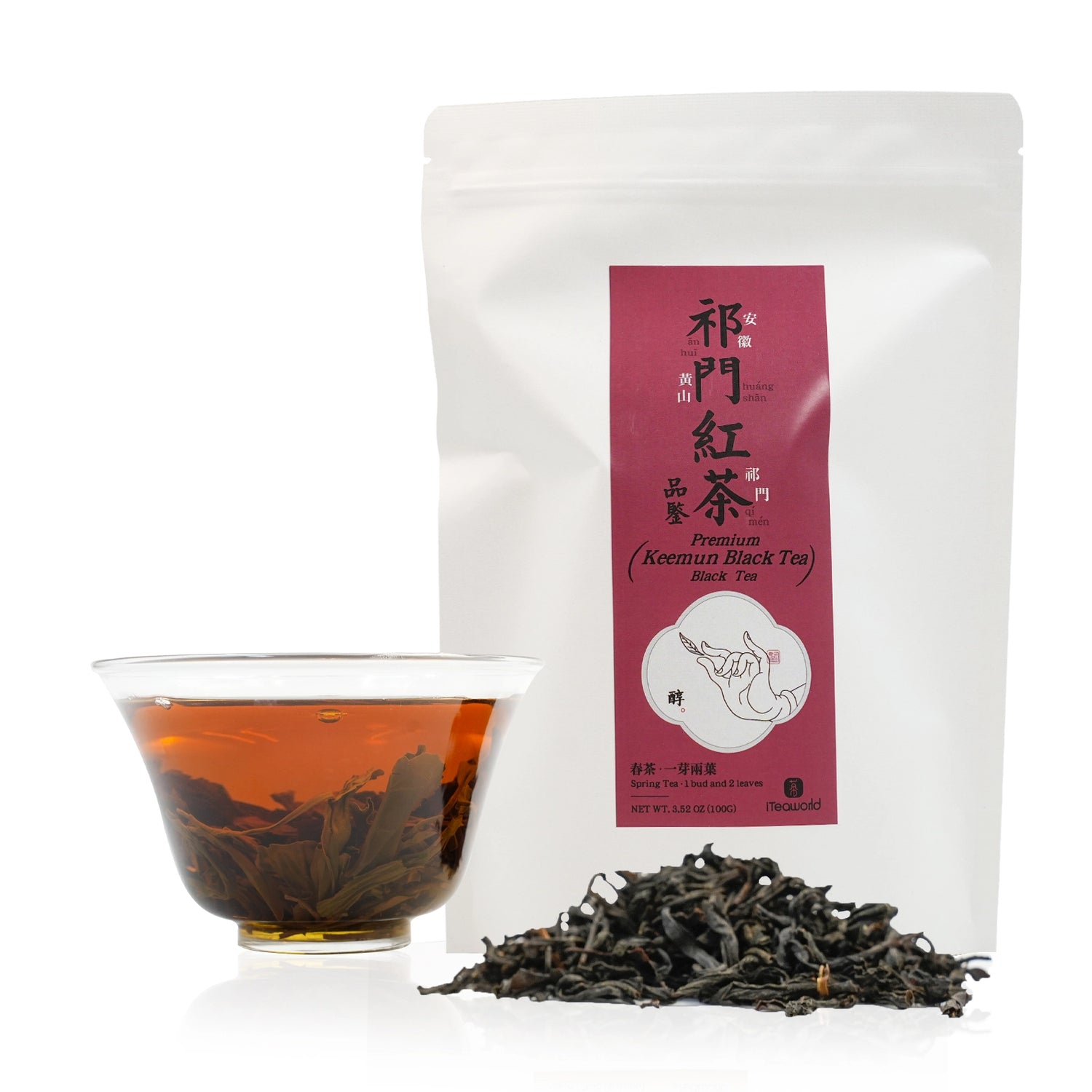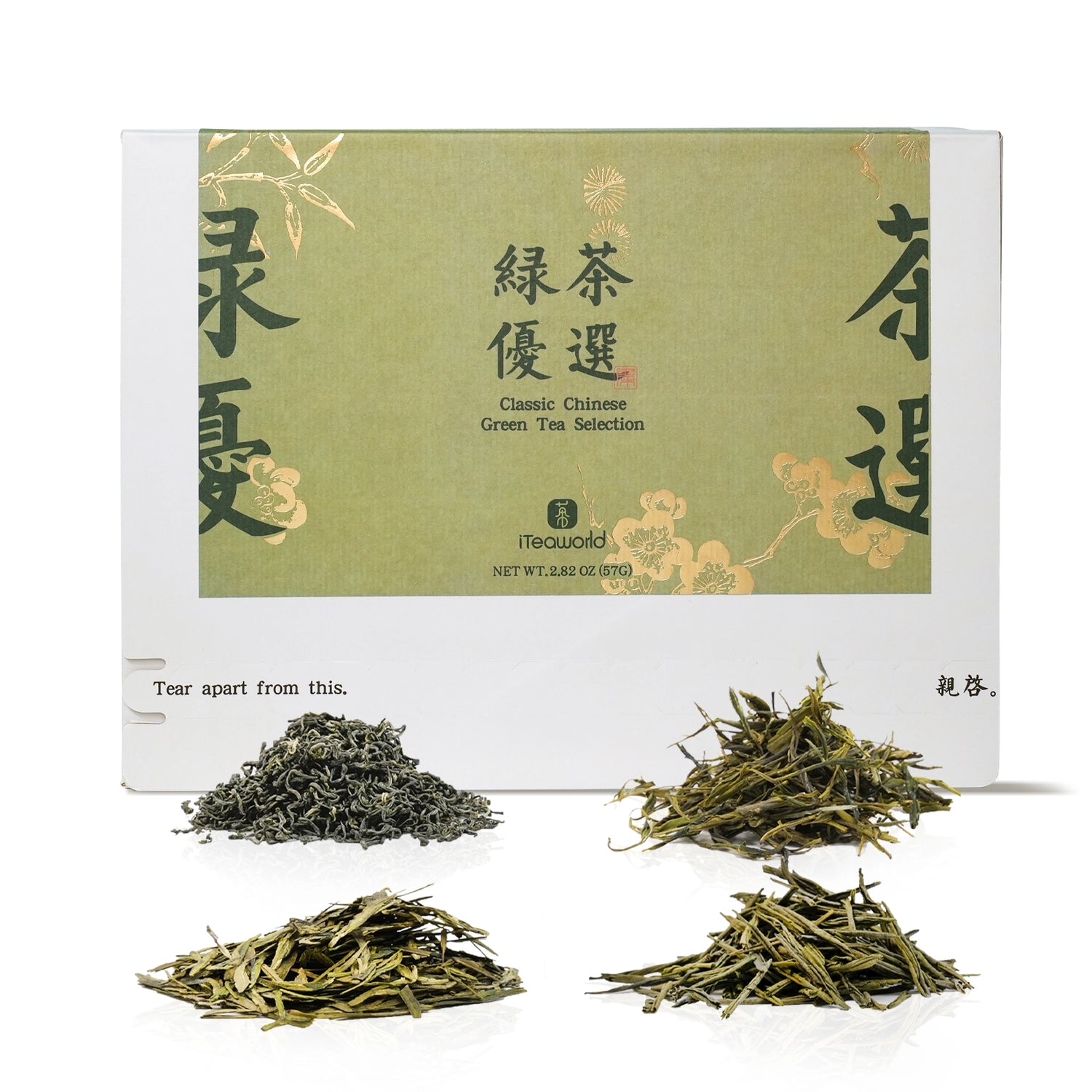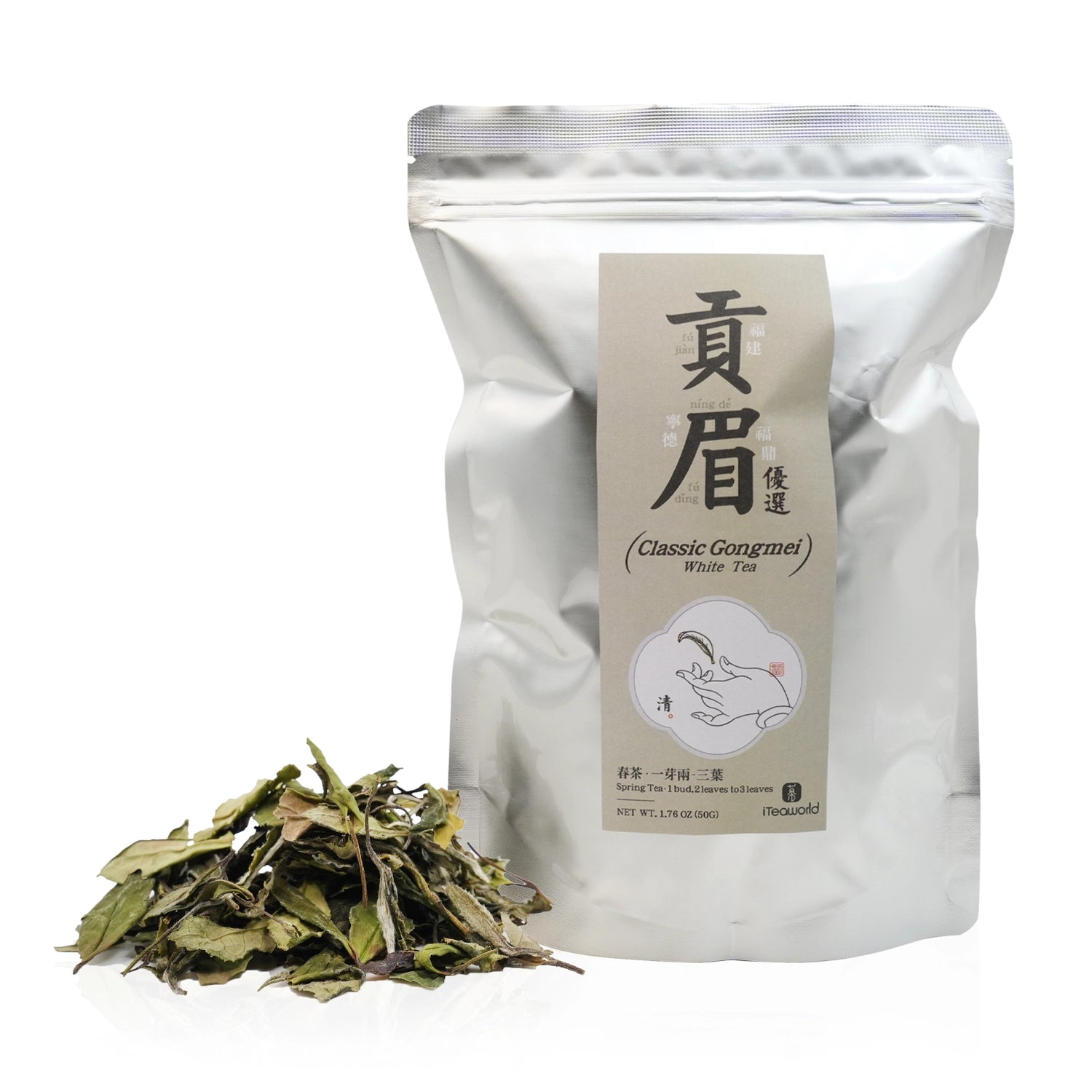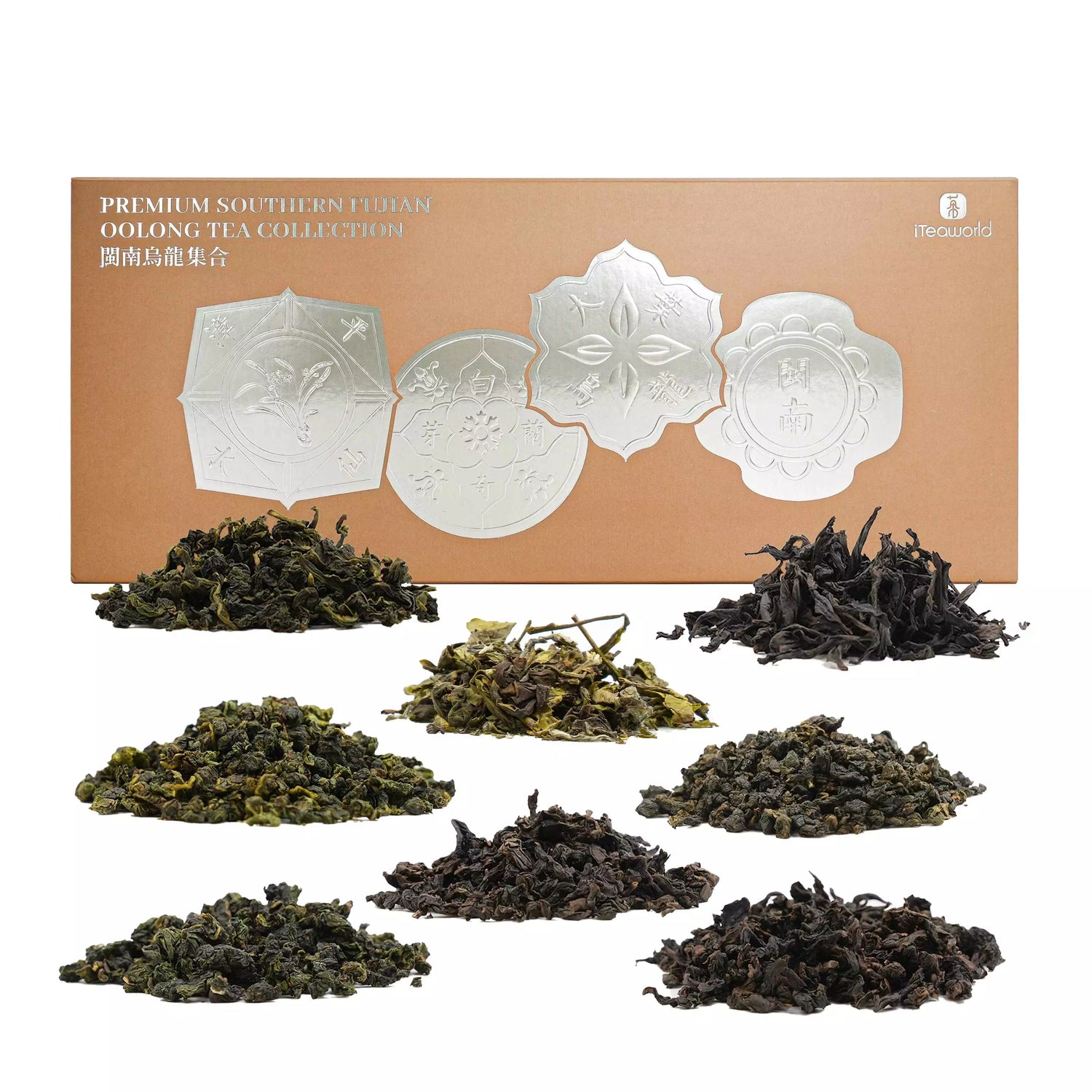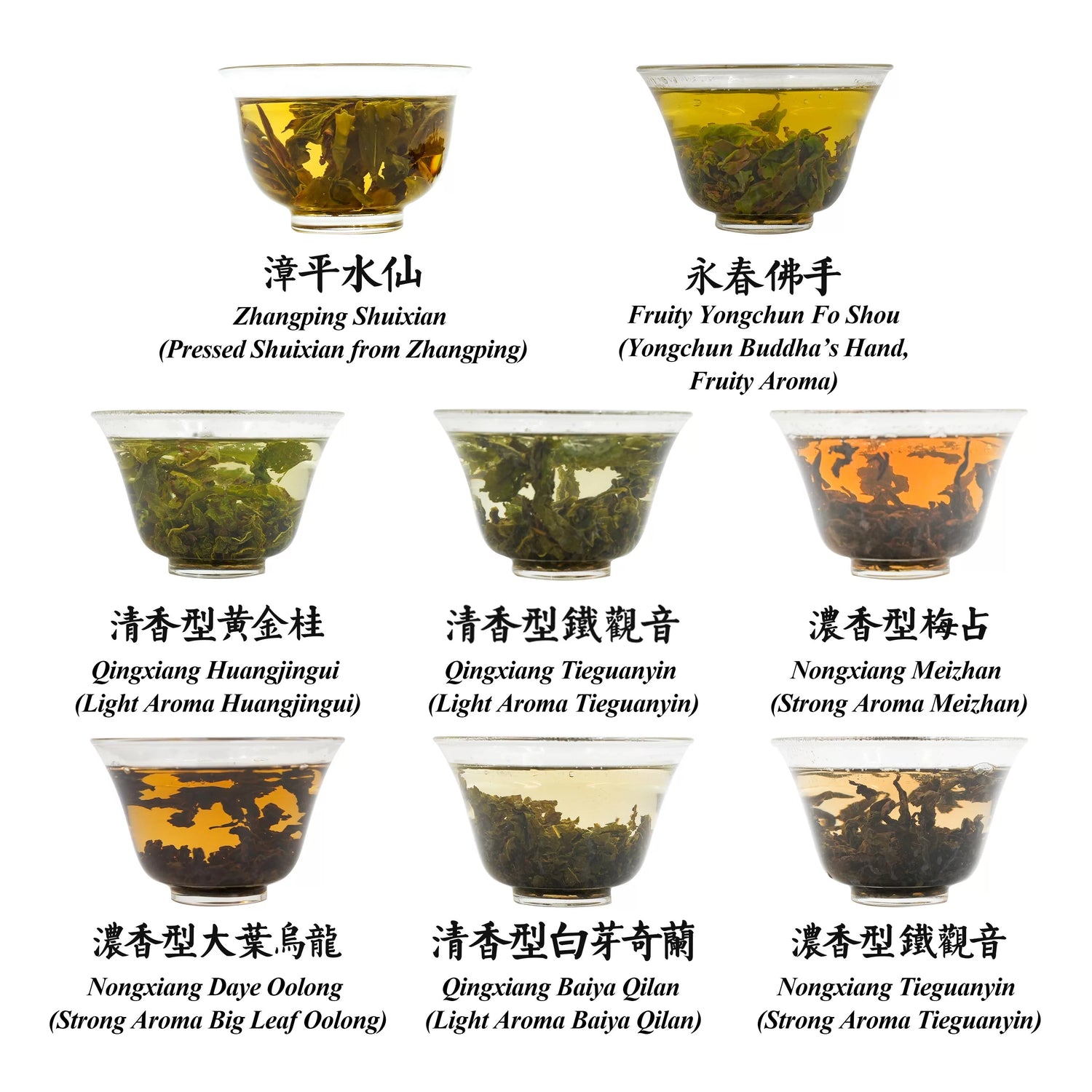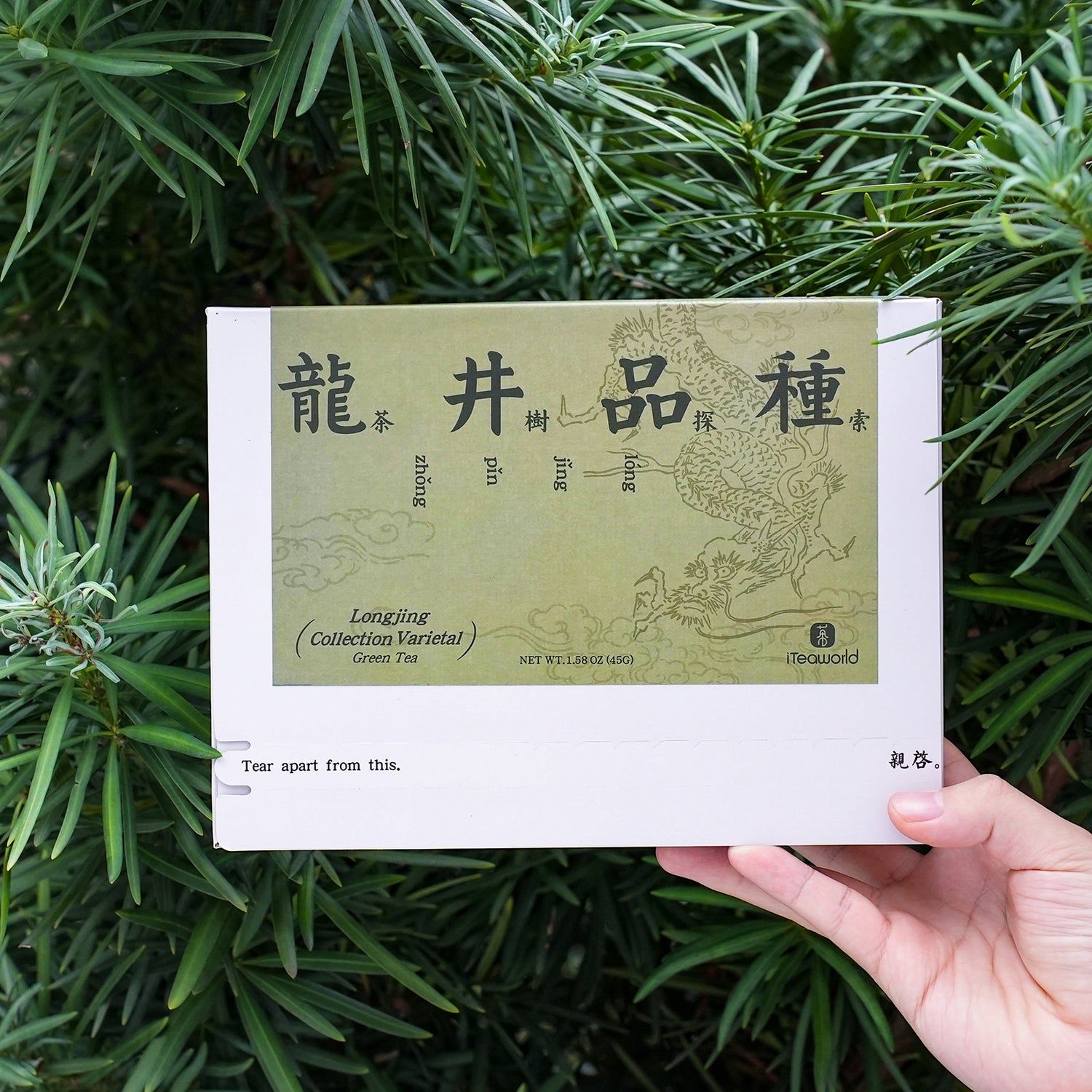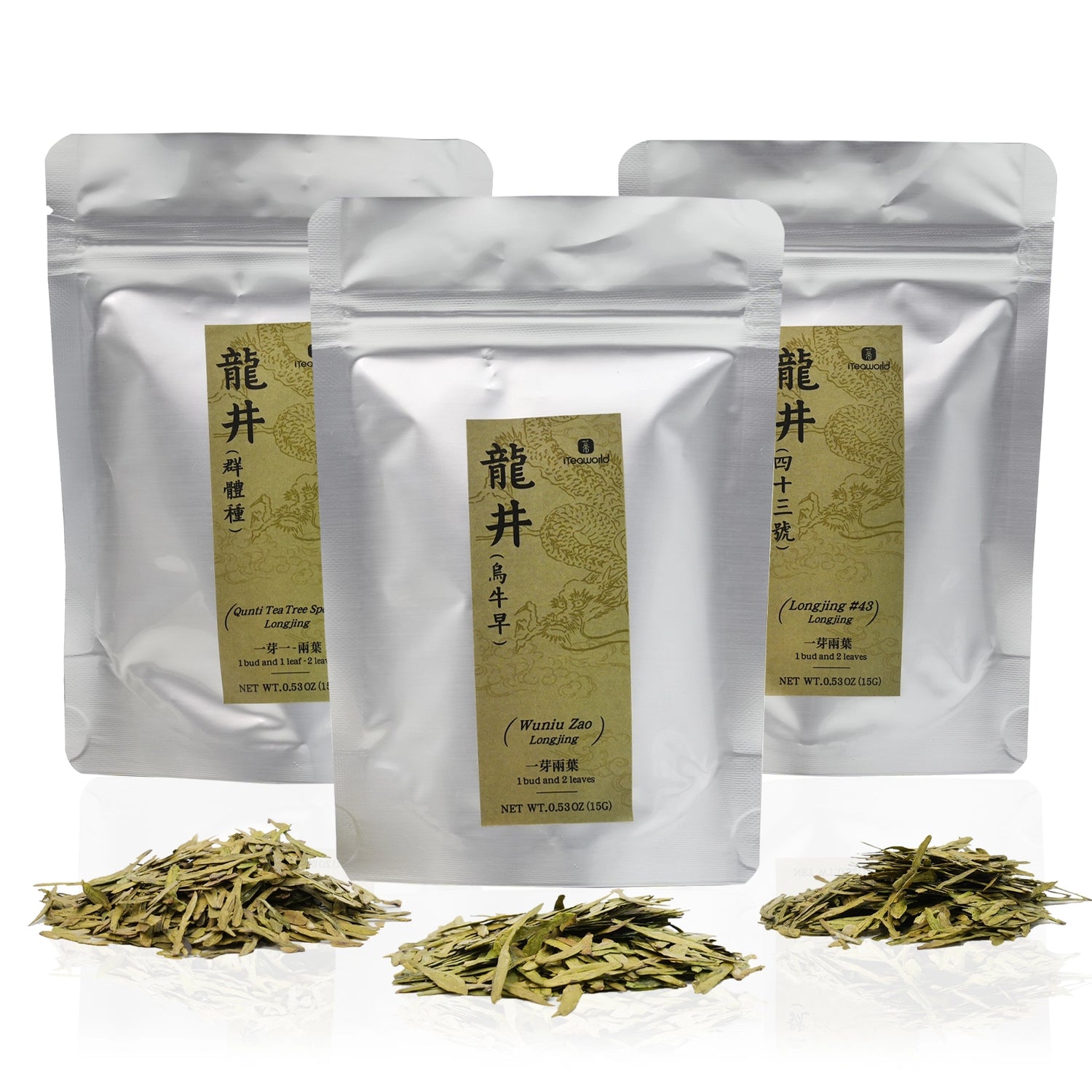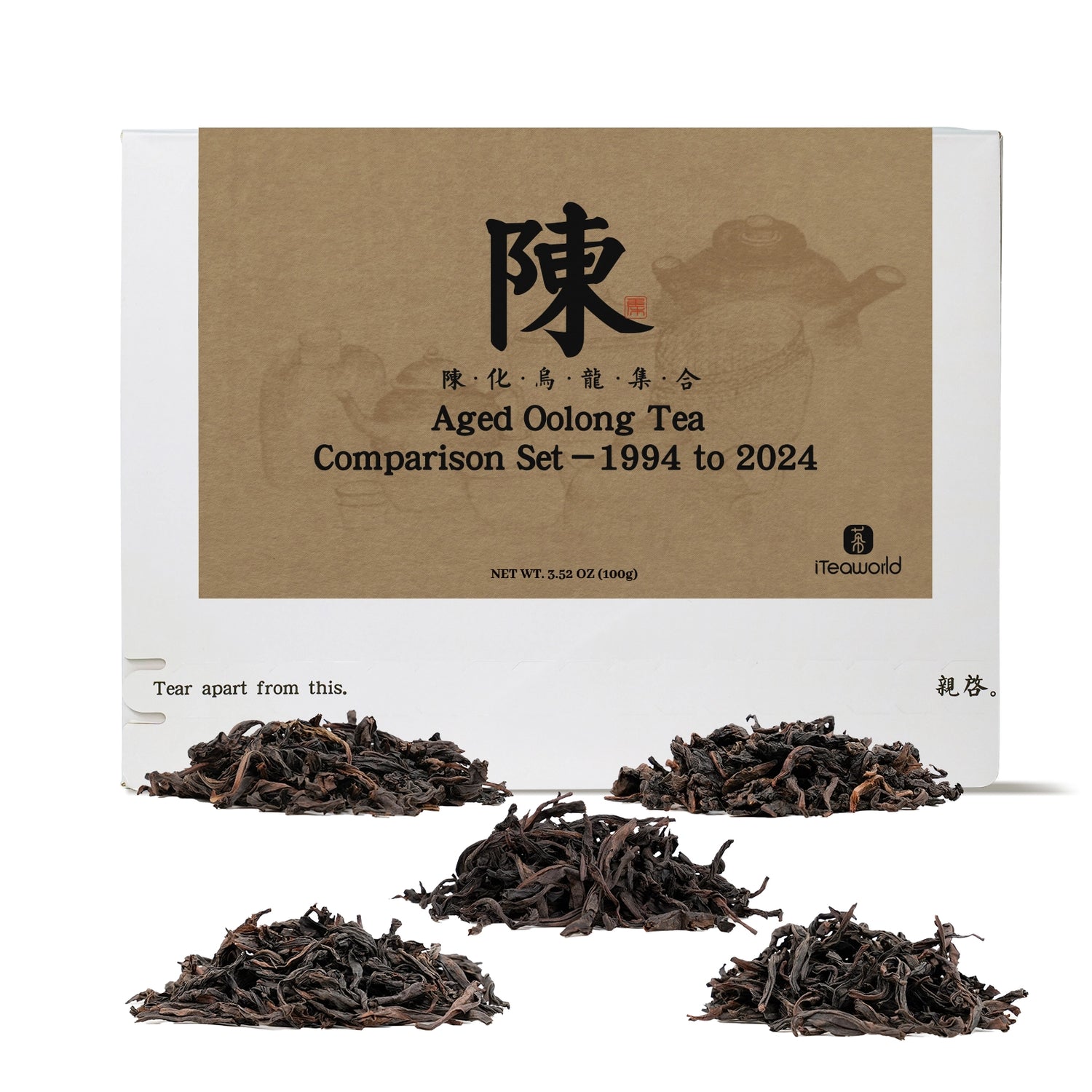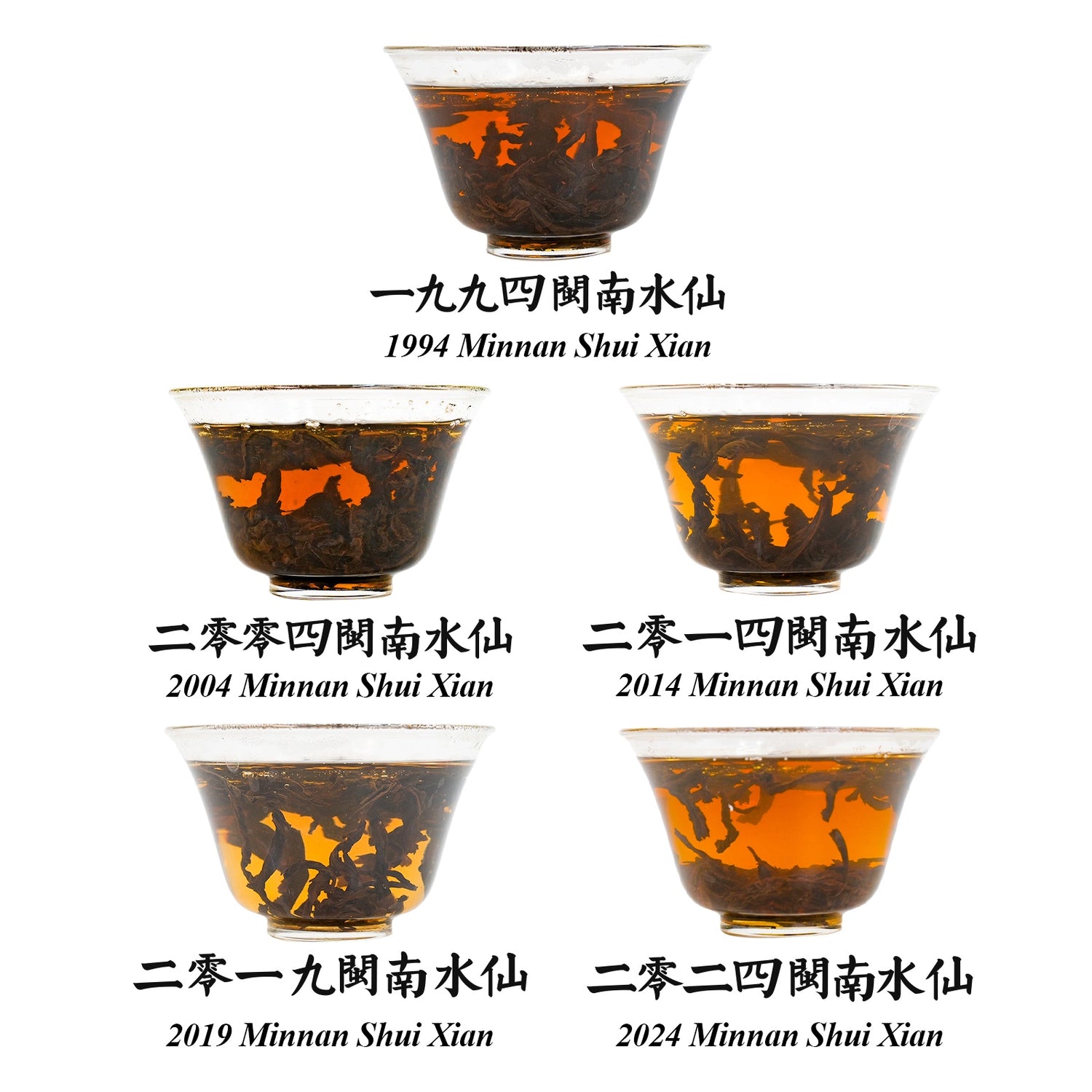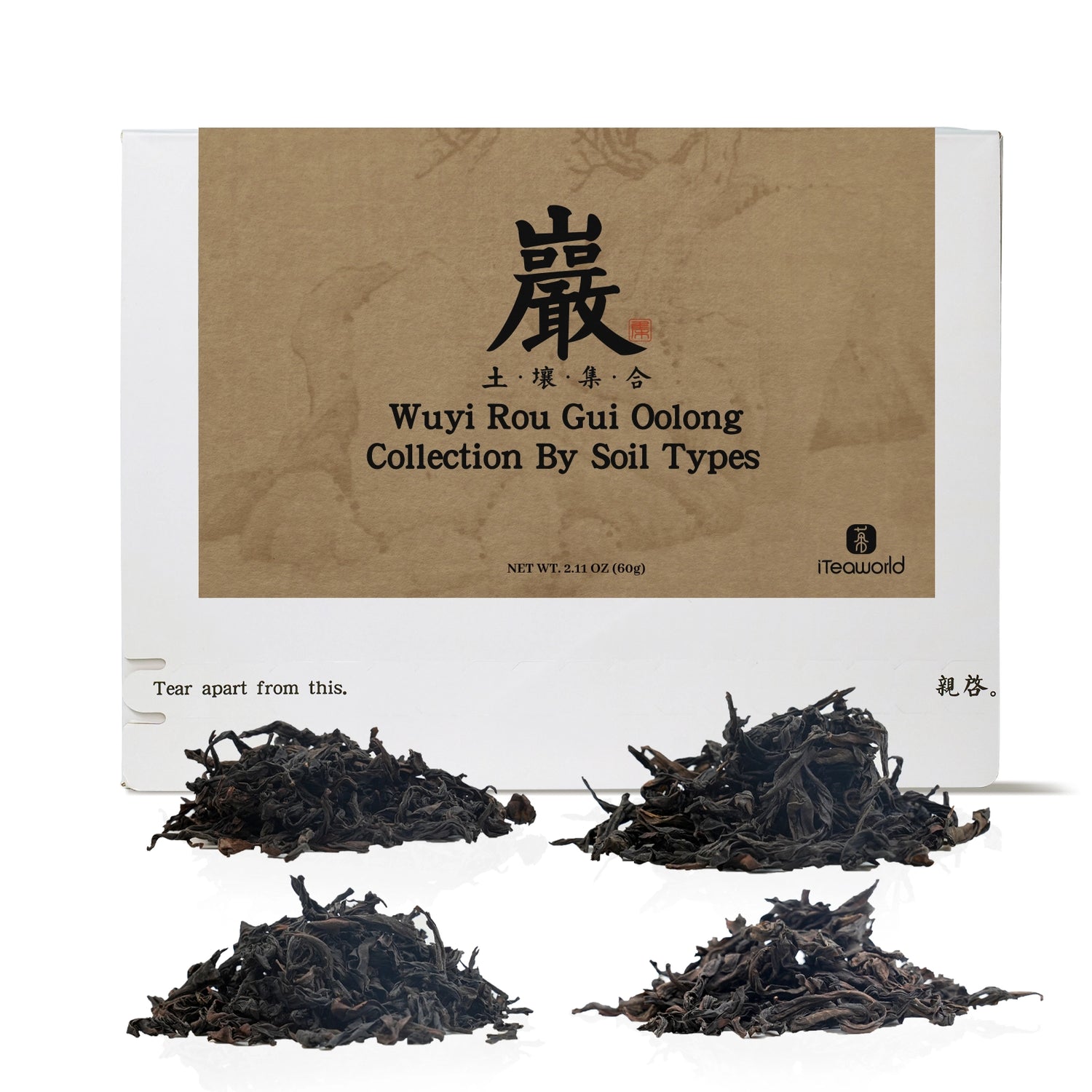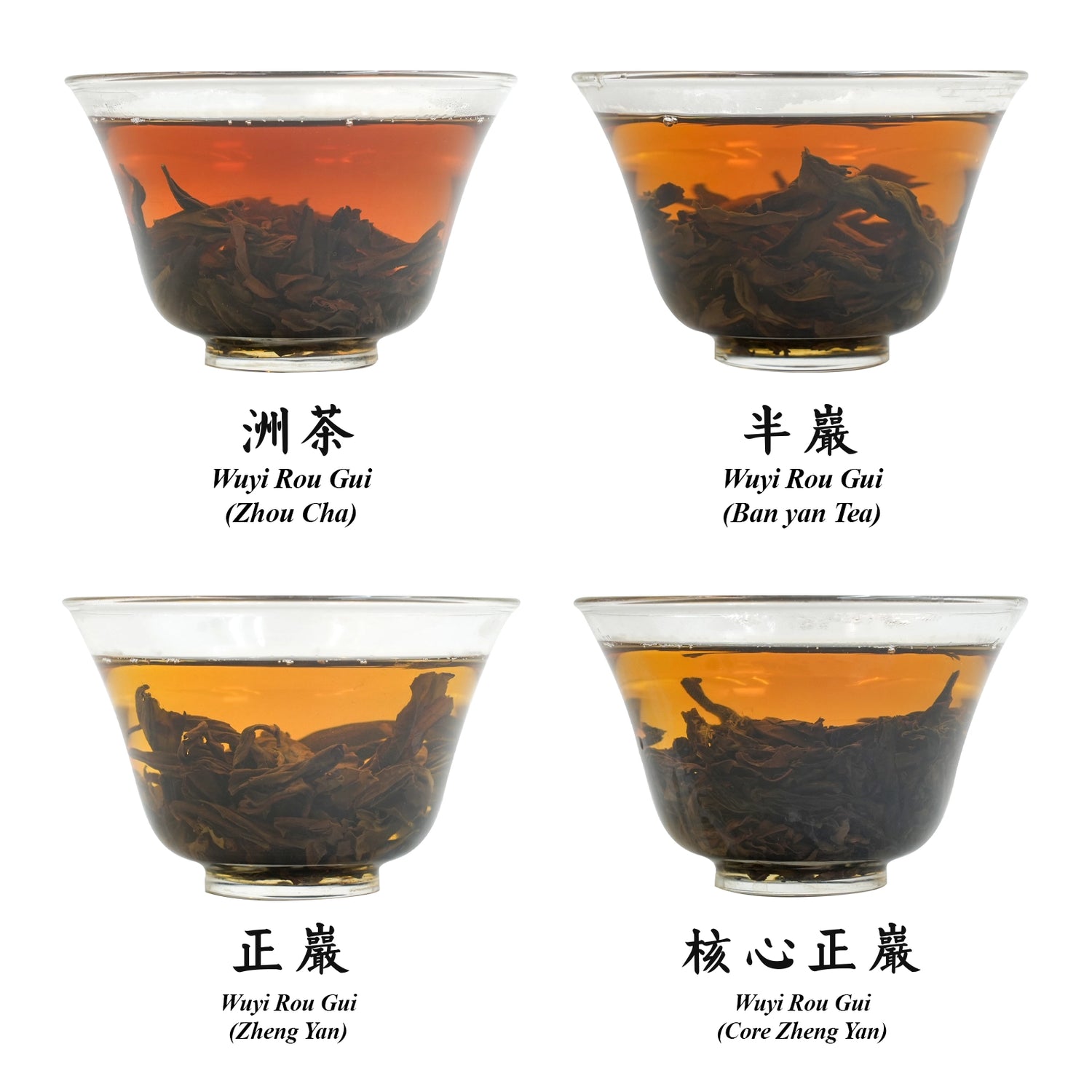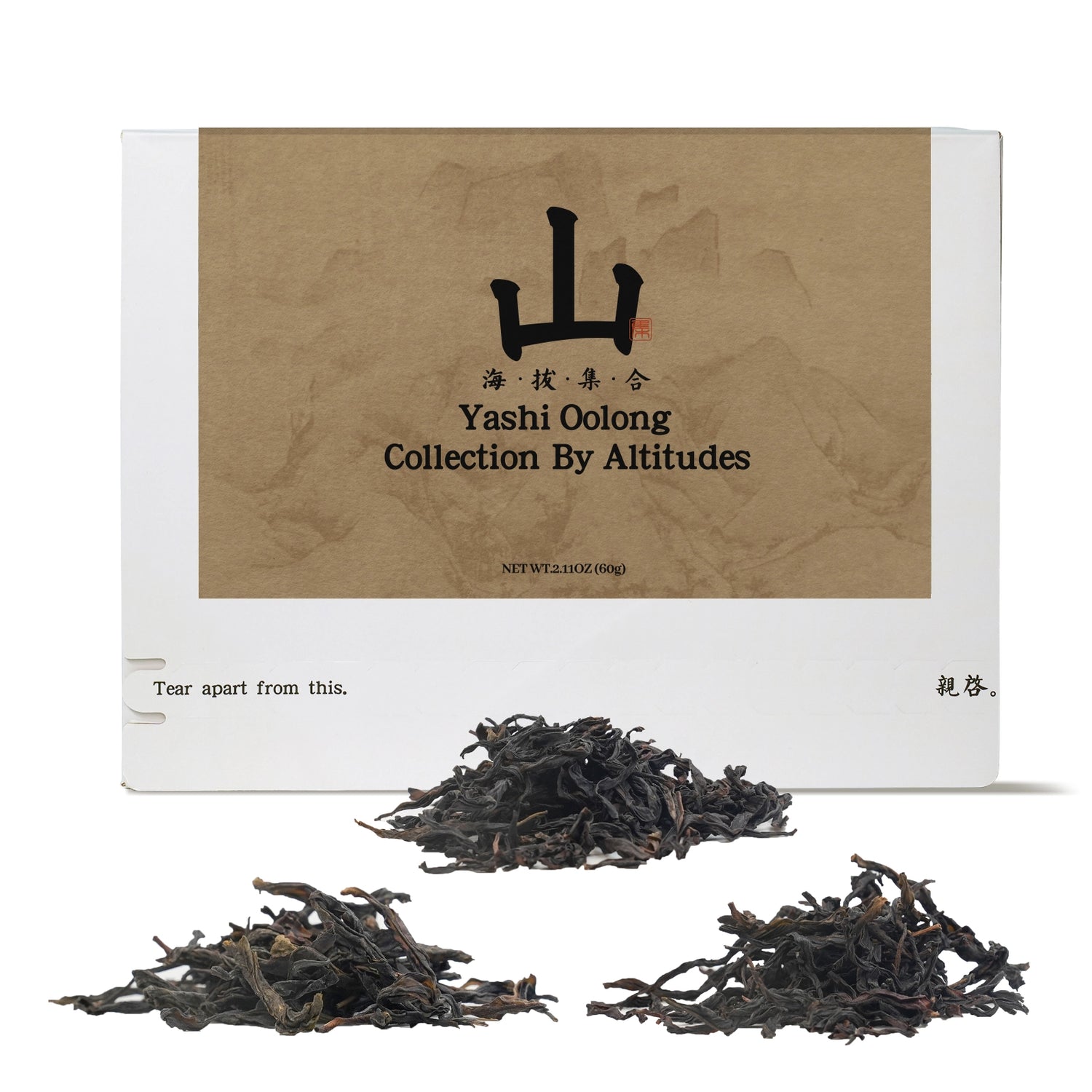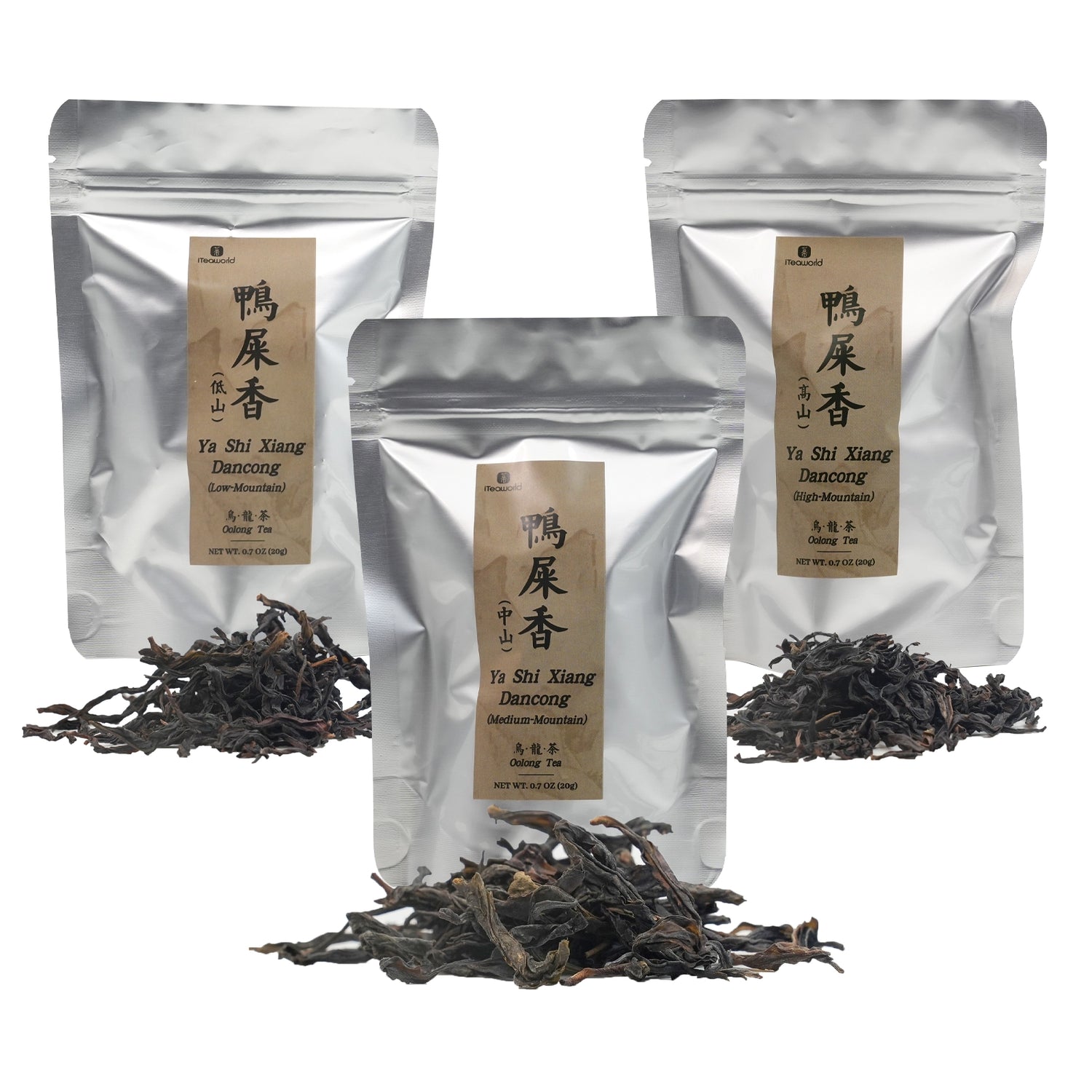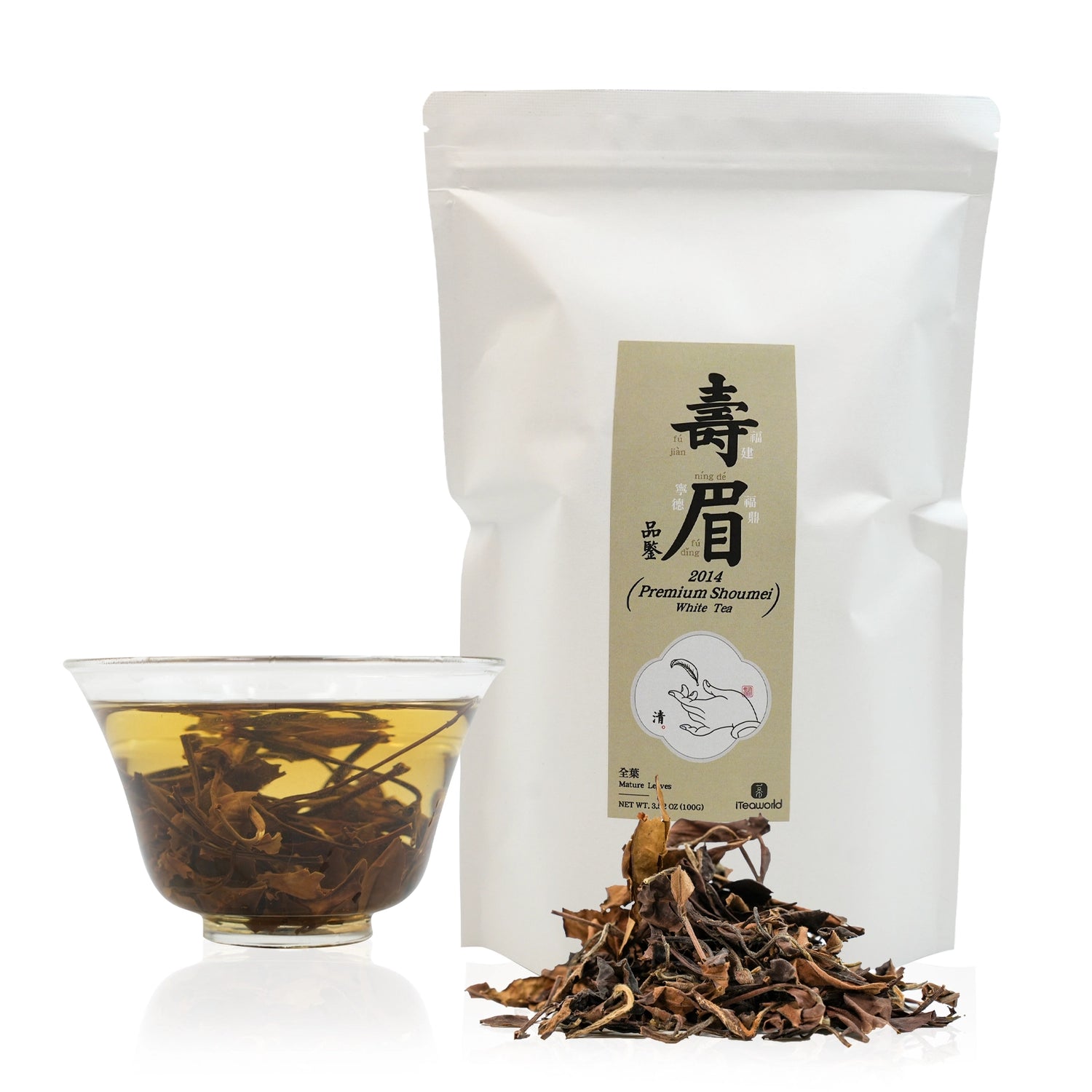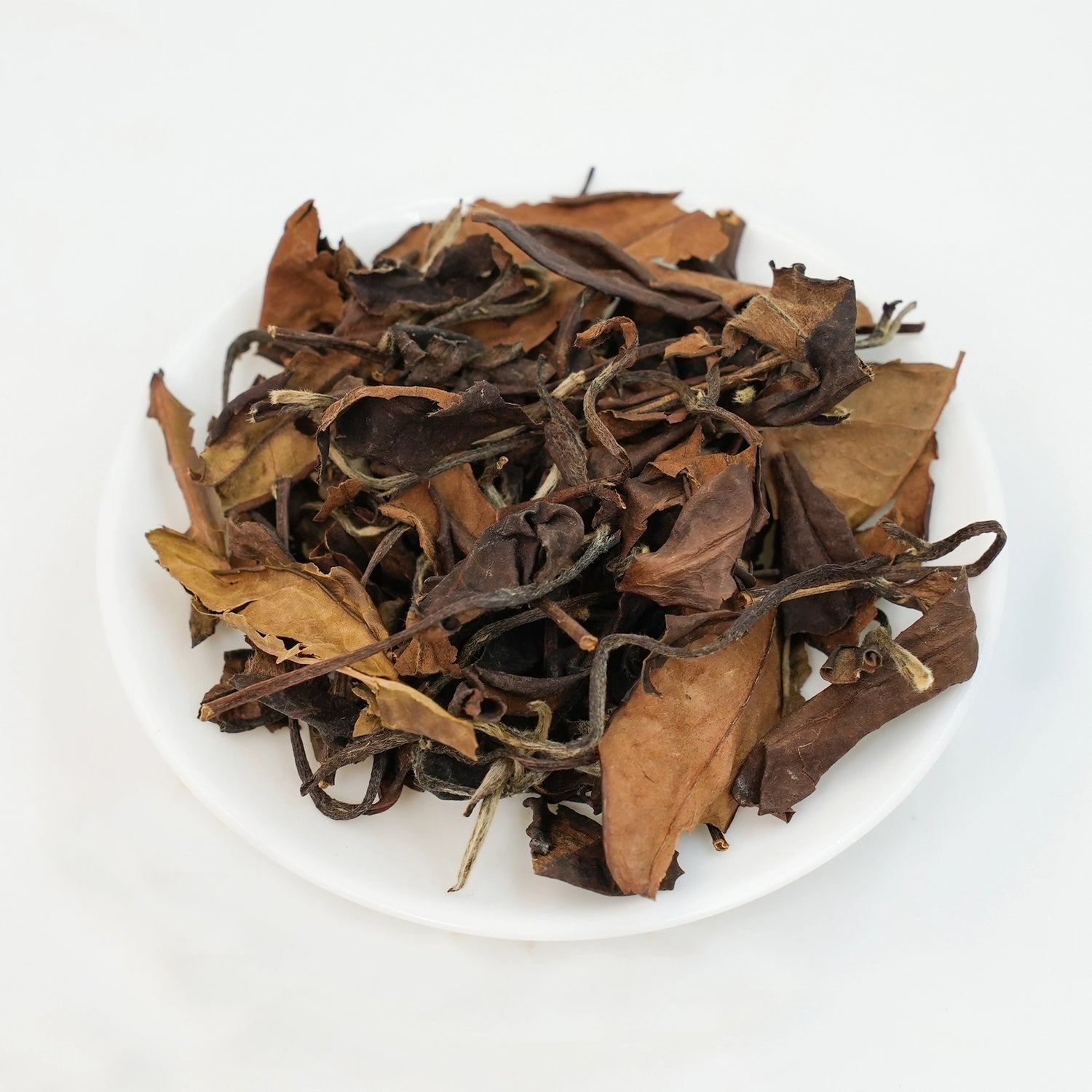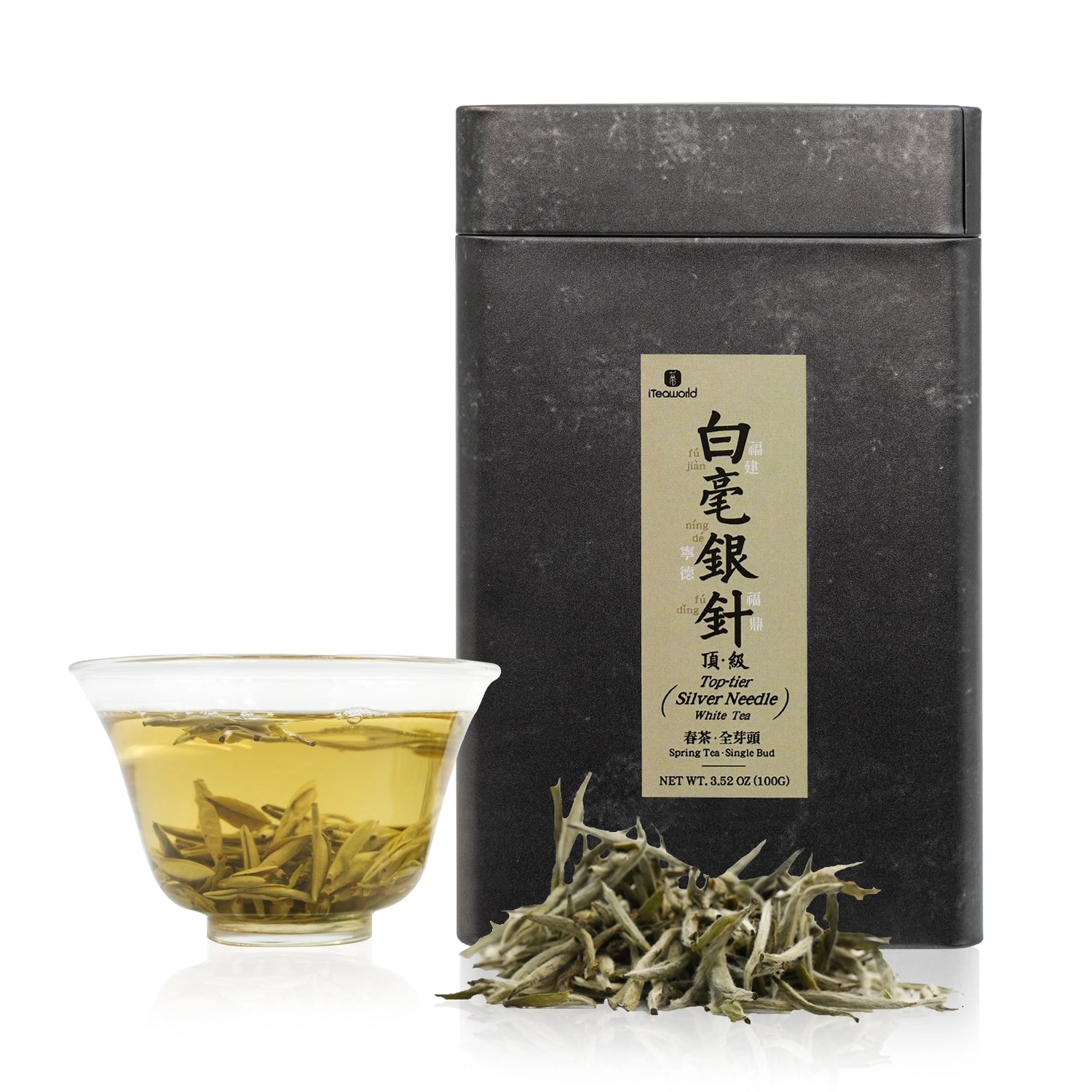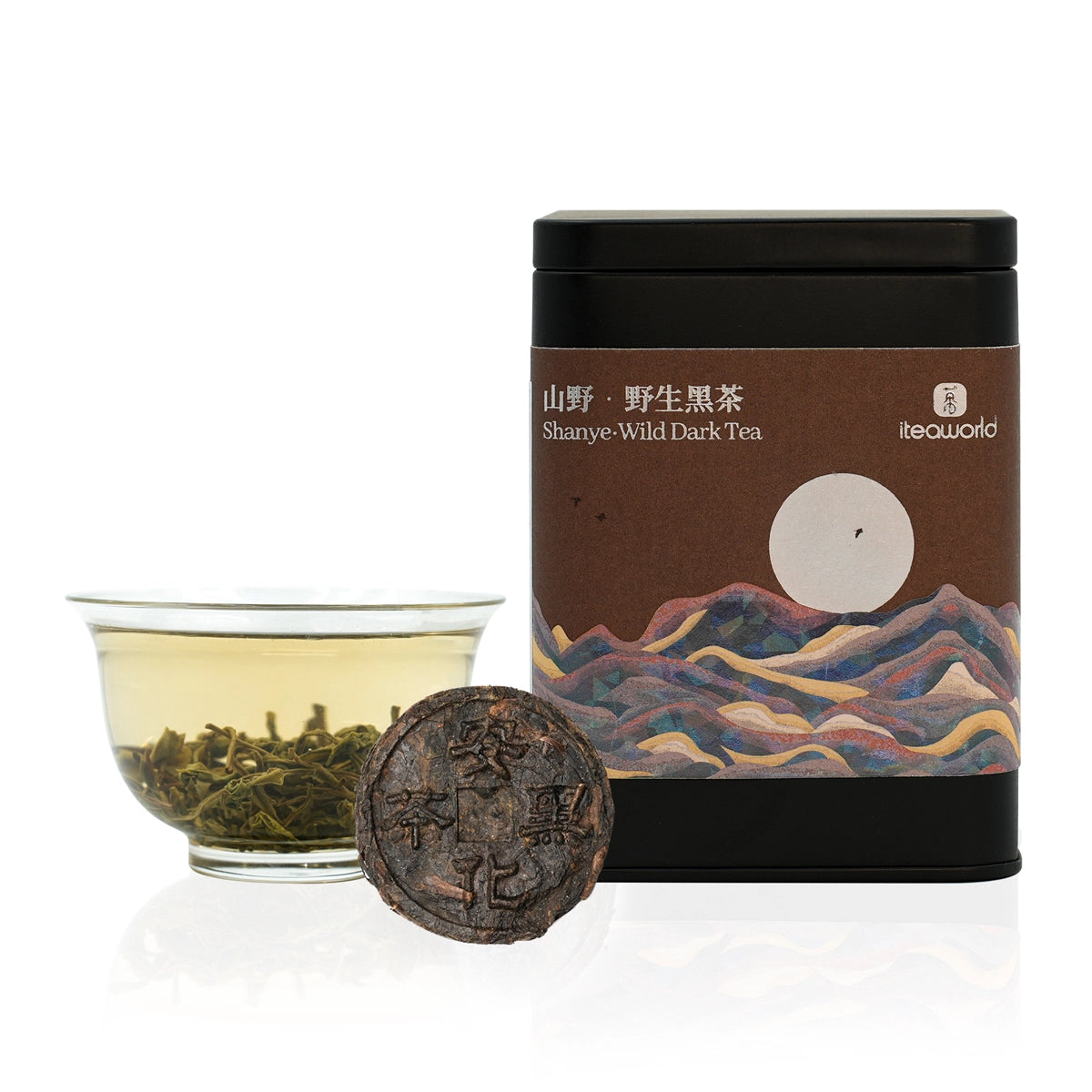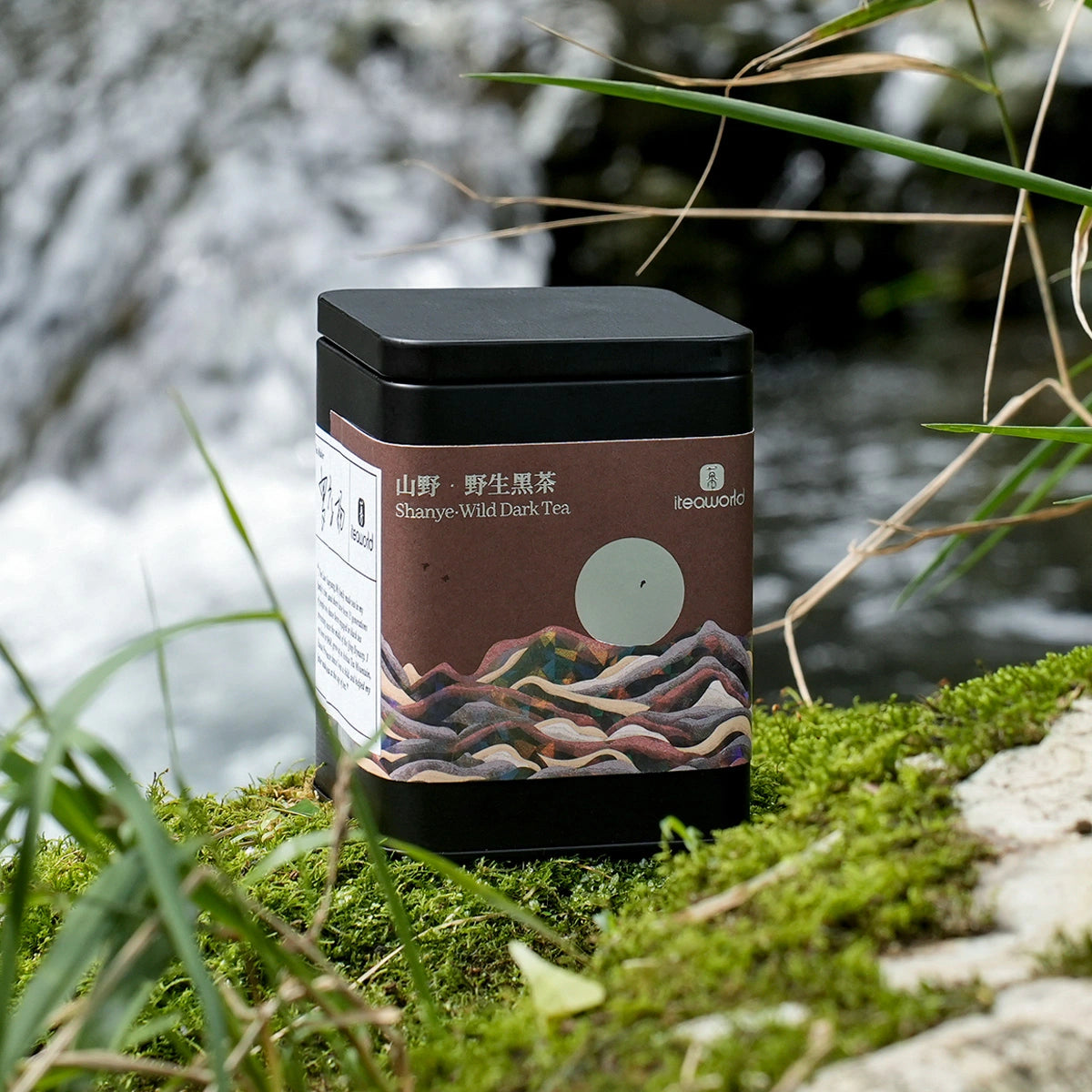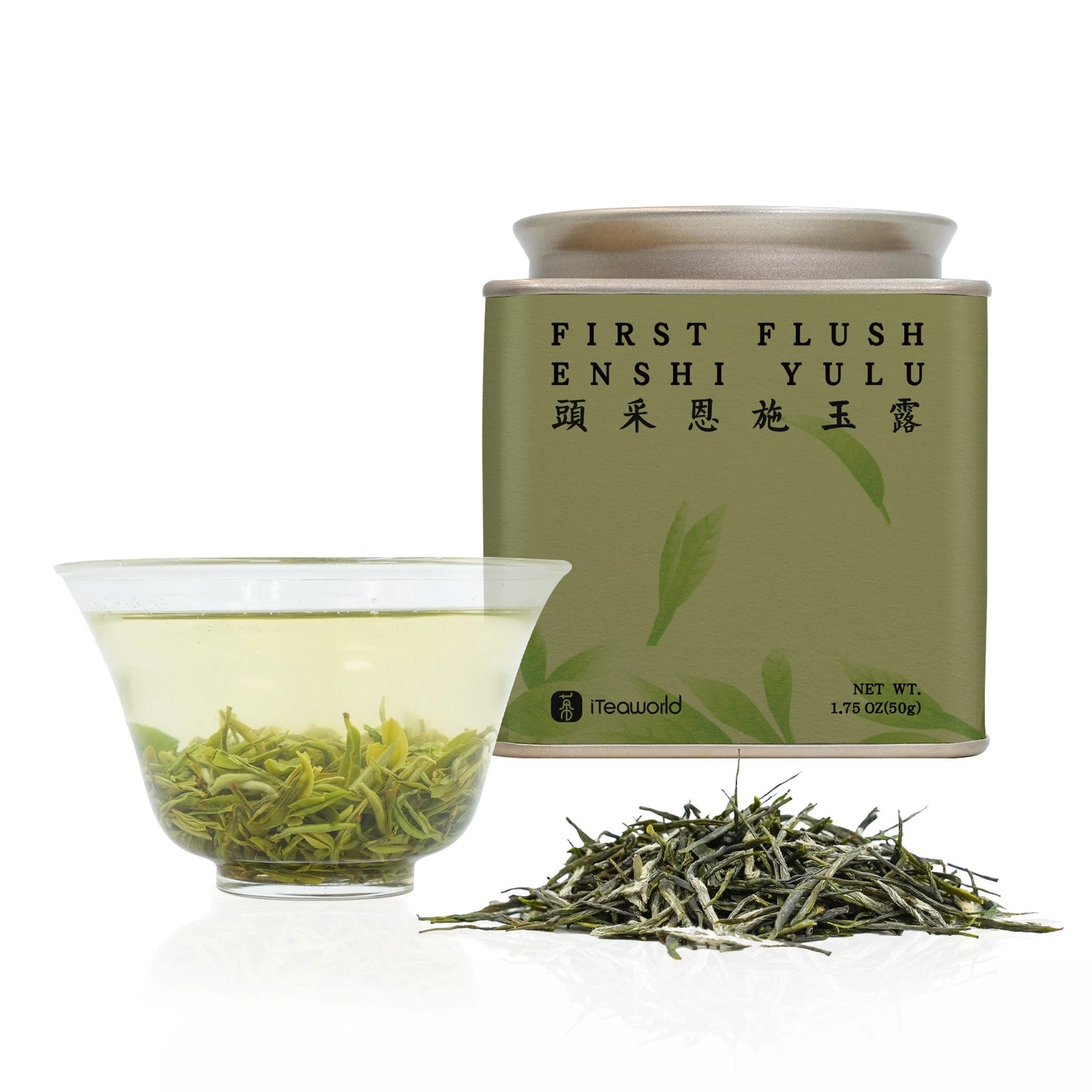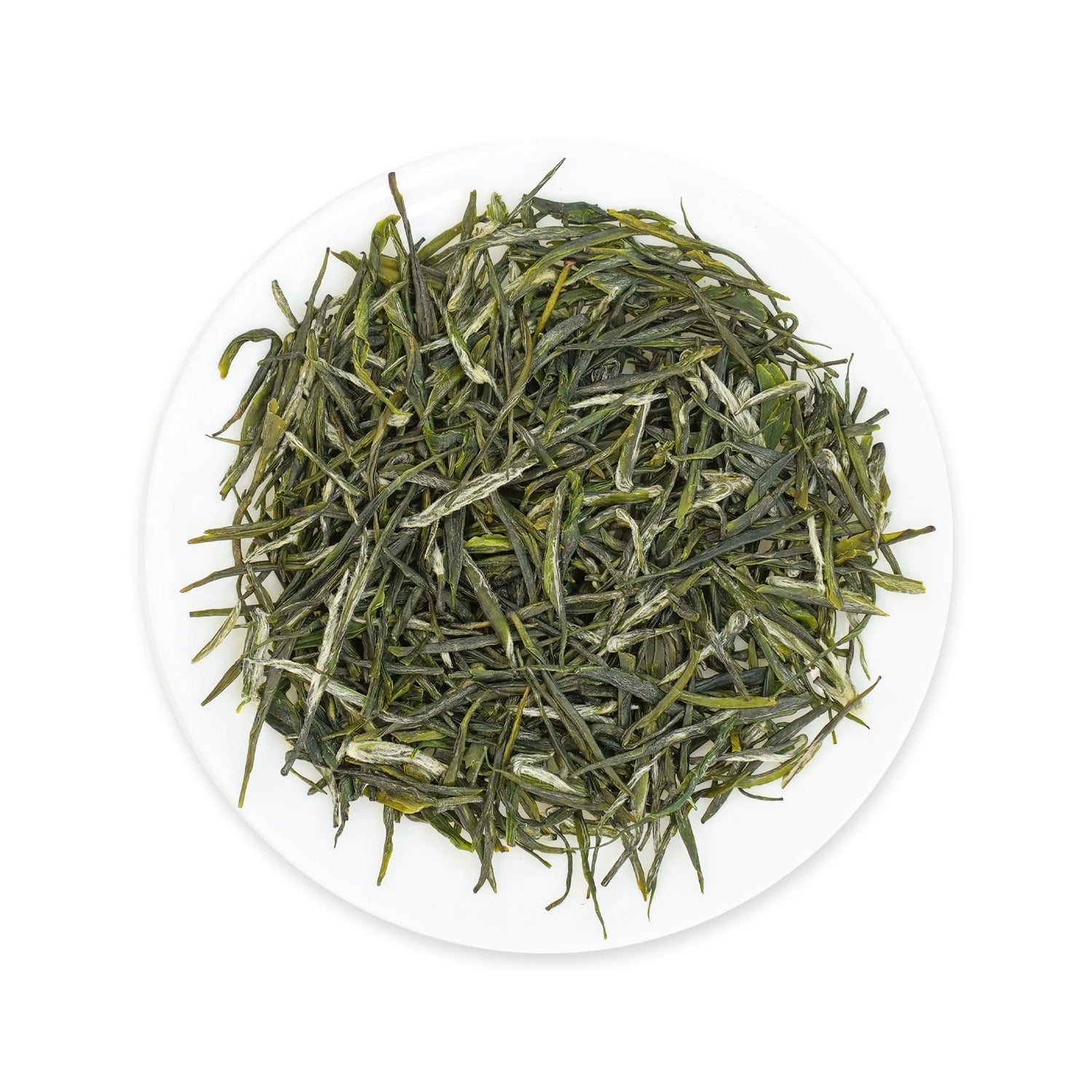Sort by:
121 products
121 products
Introduction:
This Jasmine Zhen Wang is meticulously selected from the spring harvest of 2023. Plucked from high-altitude tea gardens in Jinggu County, Yunnan Province, at elevations of approximately 1200 meters, the exceptional growing conditions impart a fresh and richly layered flavor to this jasmine tea. The plucking standard of primarily bud tips, combined with seven scenting processes, ensures a vibrant, long-lasting floral aroma, a refreshing and smooth taste, and a sweet, lingering aftertaste.
Reasons to Recommend:
- Scenting Process: High-quality green tea serves as the base, while jasmine flowers from Hengzhou, Guangxi, are used for scenting. The traditional scenting process is repeated seven times, resulting in a tea with a full, lively floral aroma and a layered complexity that gradually unfolds in the mouth with each sip.
- High-Mountain Tea Gardens: Since ancient times, high mountains shrouded in mist have produced premium teas. This tea thrives in such environments, where lush vegetation and organic-rich soil, combined with extreme daily temperature fluctuations, enhance the accumulation of flavorful compounds in the leaves.
- Whole Bud Material: The plump, straight bud tips are covered in abundant, visible white hairs, indicating their tenderness. These buds absorb the jasmine fragrance more effectively during scenting, resulting in a more intense, fresh aroma and a smoother taste. The tea retains its flavor and aroma even after multiple infusions.
Oxidation Level: None
Roasting Level: None
Processing Time: September 2024
Best Before Date: 18 months
Tea Variety: Yunnan Big Leaf
Recommended Purchase:
This authentic Keemun Black Tea from the core production area of Qimen County, Anhui, boasts a refined aroma that lingers, featuring unique notes of apple and orchid. It's best enjoyed plain to savor its natural floral and honey-like sweetness with a silky smooth finish. If you prefer bold flavors and plan to add milk and sugar, this tea might not be the perfect match for your taste.
Product Details:
Origin: Guanghui Village, Likou Town, Qimen County, Huangshan, Anhui Province
Harvest Date: April 15, 2024
Grade: Second Grade (Mao Feng), one bud and two leaves
Tea Cultivar: Qimen Zhuye (Qimen Broad Leaf Variety)
Craftsmanship: Traditional methods by tea master Feng Guochang
Flavor Profile: Distinctive "Keemun aroma" with apple and orchid notes, a refined and long-lasting fragrance, prominent floral and honey tones, and a sweet, smooth finish.
Highlight: An authentic Keemun Black Tea made from local tea trees in the core region, offering a perfect balance of flavor and richness—an excellent choice for everyday enjoyment.
About Keemun Black Tea:
Keemun Black Tea (or Qimen Hong Cha) originates from the Qimen region in Anhui Province, China, and its crafting technique is recognized as a UNESCO Intangible Cultural Heritage. Known as the "Champagne of Black Teas," it captivates tea lovers with its signature floral, fruity, and subtle smoky notes. During Victorian England, Keemun Black Tea was considered a luxury, often gracing royal and aristocratic tea tables. It became a staple in classic English Breakfast and afternoon tea blends. Compared to Ceylon and Assam teas, Keemun is more mellow and smooth, making it a refined choice for pairing with milk or sugar. Over time, it has earned its place as a luxurious favorite among Western black tea enthusiasts.
How to Brew
Water Temp: 203°F(or 95℃)
Tea-to-Water: 1g per 50ml
Steep Time: 20 sec for first 3 steeps, add 5 sec each time after
Teaware: White porcelain gaiwan
Re-Steep: 5-7 times
Someone asked, "I'm new to Chinese green tea and want to try some well-known varieties without compromising on quality." This collection is curated just for that. We've handpicked the top 4 out of China's 10 famous green teas: Longjing, Biluochun, Huangshan Maofeng, and Lu'an Guapian. We've sourced these directly from authentic growers in the classic production areas, offering great value for money. Additionally, we've chosen high-altitude teas from seed-propagated group plantations and crafted by tea masters with over 20 years of experience. Each tea is a spring harvest from 2024. Here's a brief introduction to each:
Lu'an Guapian: A Unique Green Tea 15g
Lu'an Guapian is a historic Chinese tea that was once a tribute to the royal family. This precious green tea still maintains its unique traditional craftsmanship and flavor. Our gourmet Lu'an Guapian is handcrafted by a master with 30 years of experience, using leaves from the small-leaf tea plants in Qi Mountain, Lu'an, Anhui, grown at an altitude of 600 meters. Picked at the end of spring, the leaves are tender with a rich aroma and a refreshing taste. The end-of-spring tea is more affordable than early spring tea, with a more pronounced tea flavor and a slightly reduced aroma. Lu'an Guapian is picked by selecting only the second leaf from the bud and two leaves, discarding the stem and tender leaves, retaining the essence of the tea to ensure the purity and delicate freshness of the tea soup.
Biluochun: A Premium Green Tea from China 15g
Biluochun is one of China's most famous green teas, known for its high-temperature killing and initial pan-frying followed by slow low-temperature drying. Unlike Longjing's pan-frying, dried green tea has a distinct bean flavor, but Biluochun's frying aroma is not prominent, offering a more refreshing taste. This high-grade Biluochun has a slight floral and fruity fragrance, slightly sweet without bitterness, and abundant downy hairs. Despite its high grade and flavor, it's affordably priced because it's made from tea plants in Sichuan, not the authentic Dongting Biluochun from Suzhou, Zhejiang.
Huangshan Maofeng: A Delightful Green Tea 12g
Huangshan Maofeng represents the high-mountain green teas of China, grown from 60-year-old tea trees in loamy soil at an altitude of 800 meters. Crafted by experienced tea masters using traditional drying techniques, this tea offers a perfect balance of quality and value. It's rich in minerals and exudes a refreshing green tea aroma with a subtle orchid fragrance. Its sweet and gentle flavor is endlessly memorable, making it ideal for daily drinking, especially for those who prefer a sweet taste without bitterness. The spring-picked high-mountain leaves add to its unique sweet taste and soft texture.
Longjing: A Famous Green Tea 15g
We're committed to providing an authentic Longjing tea, different from the popular low-grade "machine-cut Longjing." Our tea is selected from the traditional Longjing variety in Lishui, Zhejiang, crafted semi-manually by Longjing masters with over 30 years of experience, combining traditional techniques with modern conveniences. We choose to pick our tea after Grain Rain and before the beginning of summer, when the flavor is similar to pre-Grain Rain tea, but more affordable. Our tea comes from high-altitude gardens (900-1000 meters), where the climate and altitude provide an environment similar to West Lake, ensuring superior quality and value.
Our Longjing tea is of a high grade, carefully selected from one bud and two leaves to one bud and three leaves, offering complete leaves in contrast to the machine-cut tea with more stems and incomplete leaves. Our goal is to offer a genuine variety and craftsmanship of high-quality Longjing tea at an entry-level price, ensuring every cup exudes the pure aroma and elegant taste of traditional Longjing
Introducing Lu'an Guapian
a historic Chinese tea with a royal past, once a tribute only enjoyed by the imperial family. This precious green tea still upholds its unique traditional craftsmanship and flavor profile. Our gourmet Lu'an Guapian is handcrafted by a master tea maker with 30 years of experience, using leaves from the small-leaf tea plants in Qi Mountain, Lu'an, Anhui, grown at an altitude of 600 meters. Picked at the end of spring, the leaves are tender, with a rich aroma and a refreshing taste. Late spring teas offer a more affordable price compared to early spring teas, with a more pronounced tea flavor and a slightly reduced aroma.
Why choose our Lu'an Guapian?
It comes from the core production area of Lu'an Guapian in Lu'an City, Anhui Province, ensuring authenticity.
Crafted by a seasoned tea farmer with 30 years of tea-making experience.
Sourced from high-altitude tea plants at 600 meters, which are less susceptible to ecological pollution and offer a superior freshness and aroma.
Directly purchased from local tea farmers, offering a higher cost-performance ratio.
Made exclusively from the newest 2024 spring harvest.
Who is it suitable for?
Entry-level consumers or daily tea drinkers who want to experience the classic Chinese green tea, Lu'an Guapian.
Those seeking high cost-performance without compromising quality.
Tea drinkers who enjoy a fresh, slightly bitter, and sweet taste.
Consumers who dislike seaweed flavors and prefer a strong green tea aroma.
Not suitable for:
Those who prefer strong roasted or smoky flavors.
Advanced tea drinkers seeking more intense and complex flavors.
Tea connoisseurs looking for a higher level of sweetness.
Many white teas sold online in the U.S. are either of lower grades or come from Yunnan, making it tough to find authentic Fuding white tea at a reasonable price. Our Gongmei white tea from the renowned Fuding region in Fujian offers just that - an authentic taste rooted in traditional sun-drying and slow withering crafts, meticulously made from the local "cai cha" variety.
If you're looking for a genuine origin, traditional tea craft, and a balanced flavor profile – neither too light nor too strong – this tea provides excellent value for money. Its smooth and easy-drinking character makes it a perfect choice for beginners.
Why choose our Gongmei White Tea?
Genuine Origin: Our tea comes from the prestigious Fuding region in Fujian, ensuring authenticity and adherence to Fuding's high standards.
Traditional Variety: We use the local "cai cha" variety, known for its strong adaptability and imparting a rich flavor profile to the tea.
Classic Craft: Our Gongmei white tea undergoes traditional sun-drying and slow withering processes, essential for developing the tea's fresh and pure taste.
Suitable for Long-Term Storage: The quality of this tea allows for long-term storage, with its flavor becoming more elegant over time, potentially increasing in value as it ages.
High-Value Choice: For those seeking the authentic flavor of Fuding white tea without the high price tag, our Gongmei offers a high-value choice without compromising quality.
Perfect Balance: If you're looking for a white tea that's neither too light nor too strong, our Gongmei achieves a perfect balance, providing a smooth and easy-drinking experience at a reasonable price.
Ideal for Beginners: Our carefully curated Gongmei white tea offers a gentle introduction for white tea novices, avoiding the pitfalls of being too bland or too strong for new tea drinkers.
Experience the gentle charm of our authentic Gongmei white tea, with its selected quality and value, making it an ideal choice for everyday drinkers and those new to the world of white tea.
Tasting Grade Longjing Tea Product Introduction and Reasons for Recommendation:
This Tasting Grade Longjing Tea is semi-handcrafted by Master Pan, who has 30 years of tea-making experience, and is carefully selected from the freshest pre-rain spring tea of 2024. As a traditional group variety Longjing, this tea is picked from high-altitude tea gardens in Lishui, Zhejiang, at an altitude of over 900 meters, where the superior climate conditions give the tea a more refreshing taste and rich layers of flavor. The tea is picked with buds and one to two leaves, ensuring its fresh and sweet taste, accompanied by a light and elegant fragrance.
Reasons for Recommendation:
Exquisite Craftsmanship: Master Pan has 30 years of experience in making Longjing tea, combining semi-manual techniques to ensure that each batch of tea can showcase the classic taste and unique flavor of Longjing tea.
High-Altitude Tea Gardens: Compared to other Longjing teas, this tea comes from high-altitude tea gardens in Lishui, where the superior climate conditions make the tea richer in substance, sweeter in taste, and more refreshing in aroma.
Pre-Rain Harvest: Pre-rain Longjing has tender leaves and is rich in substances, with a clear and sweet tea soup, accompanied by an elegant floral fragrance, making it a top choice among high-quality green teas.
Group Variety Tea Trees: Group variety tea trees have deep root systems, resulting in a richer taste and more lasting aroma. Compared to the Longjing 43 variety, Longjing tea made from group variety tea trees is more resistant to brewing, and the tea soup has a richer taste.
Suitable for:
Consumers who pursue high-quality green tea and pay attention to cost-effectiveness.
People who like the fresh and sweet taste of Longjing and want to experience the authentic flavor of the group variety Longjing.
Not Suitable for:
Tea lovers who prefer a richer and fuller taste may find this Longjing too subtle.
If you are only looking for the core production area West Lake Longjing, this Lishui Longjing may not be within your consideration.
Whether you are looking to experience high-quality Longjing or to find an affordable and authentic green tea, this Tasting Grade Longjing Tea will be an ideal choice.
The production of Oolong tea in the Southern Fujian region dates back to the 17th century, with a wide variety of Oolong teas. Among them, the famous Tie Guan Yin and Zhangping Shui Xian have been officially recognized as part of China’s Intangible Cultural Heritage.
This curated collection showcases oolong varieties discovered and cultivated in Southern Fujian, offering a glimpse into its evolving tea history and distinct flavor profiles. Whether you’re a seasoned tea drinker or a curious explorer, this selection lets you experience the true essence of Southern Fujian oolong.
The selection includes:
Qingxiang Tieguanyin (Light Aroma Tieguanyin)* 3 bags* 5 g
Nongxiang Tieguanyin (Strong Aroma Tieguanyin) * 3 bags* 5 g
Qingxiang Huangjingui (Light Aroma Huangjingui)* 3 bags* 5 g
Zhangping Shuixian (Pressed Shuixian from Zhangping)* 3 bags* 5 g
Yongchun Fo Shou (Yongchun Buddha’s Hand, Fruity Aroma)* 2 bags* 5 g
Qingxiang Baiya Qilan (Light Aroma Baiya Qilan)* 2 bags* 5 g
Nongxiang Meizhan (Strong Aroma Meizhan)* 2 bags* 5 g
Qingxiang Daye Oolong (Light Aroma Big Leaf Oolong)* 2 bags* 5 g
Processing Time: May 2024
Best Before Date: 36 months
Southern Fujian (Minnan)Oolong Tea: A Flavor for Every Era
1. Origins (Kangxi Period, Qing Dynasty)
Anxi is the birthplace of Minnan Oolong tea. During the Qing Dynasty's Kangxi period, a Yongchun monk grafted Anxi tea plants with native citron trees, creating the unique Yongchun Fo Shou tea, known for its distinctive fruity aroma and mineral depth.
2. Golden Age (from Qianlong to Xianfeng Periods, Qing Dynasty)
In the 18th century, Minnan Oolong entered its golden age. Wang Shiran from Anxi discovered a rare tea tree and made tea from it, which was presented to Emperor Qianlong. The tea was named Tie Guan Yin, due to its "iron-like weight" and "Guanyin-like shape." With its bold flavor and growing demand in Southeast Asia, it became a major export tea.
In the Xianfeng period, Anxi tea farmers selected and cultivated the Huang Jin Gui. Known for its osmanthus-like fragrance, it became a symbol of Minnan’s high-aroma Oolong teas.
3. Transformation (Late 19th to Early 20th Century)
To meet the needs of overseas markets, Minnan tea farmers developed Mei Zhan and Da Ye Oolong. Meanwhile, Zhangping Shui Xian evolved its unique "square tea cake" shape, becoming the only compressed Oolong tea.
Mei Zhan: Noted for fruity sweetness and strong infusions
Da Ye Oolong: Known for its thick texture and caramel notes, great for blending
Zhangping Shui Xian: Complex fragrance with intertwined orchid and osmanthus notes, smooth and refreshing taste.
4. Innovation (Beginning of the 20th century)
As technology advanced, Minnan Oolong entered a new era. In the 1980s, Pinghe County discovered Bai Ya Qi Lan, celebrated for its crisp orchid aroma.
Unique Crafting Characteristics:
- The fermentation level is typically between 10% and 25%, making it a lightly fermented Oolong tea.
- The repeated rolling and wrapping for the Shaping process is a key feature that distinguishes Minnan Oolong from other Oolong teas, shaping its unique appearance.
- Multiple rounds of slow roasting at low heat are used to enhance the tea's aroma.
- The leaves undergo multiple cycles of shaking and resting to achieve the perfect balance of "three reds and seven greens" in the leaf base.
How to Brew Minnan Oolong?
1. Choose the Right Teaware
White porcelain gaiwan – Best for lightly oxidized, lightly roasted oolongs, as it preserves delicate floral notes.
Yixing clay teapot – Ideal for richer, heavily roasted or charcoal-roasted oolongs, enhancing depth and smoothness.
2. Water Temperature Matters
Use boiling water (100°C / 212°F) for full aroma and body.
Water below 90°C (194°F) results in weaker flavor and muted fragrance.
3. Tea-to-Water Ratio
7–8g of tea for a 110ml gaiwan (about ⅓ full).
Standard ratio: 1:15 (tea to water)—adjust based on preference.
4. Use the Right Water
Soft, slightly alkaline spring water or purified water is best.
Avoid tap water with high mineral content, as it can mute the tea’s natural flavors.
5. Preheat Your Teaware
Rinse the gaiwan and cups with boiling water before brewing.
This warms the vessels and prevents temperature shock, allowing the aroma to bloom fully.
6. Wake Up the Tea (Rinse Infusion)
Pour boiling water over the leaves and immediately discard (within 10 seconds).
This removes any impurities and "wakes up" the leaves for optimal flavor release.
7. Proper Pouring Technique
Pour water gently along the inner wall of the gaiwan.
This helps the leaves unfurl evenly and enhances the fragrance.
8. First Infusion Timing
7–15 seconds for the first steep:
Lightly roasted teas need a shorter steep.
Heavily roasted teas can steep slightly longer.
9. Subsequent Infusions
Increase steep time by 5–10 seconds per infusion.
High-quality oolong can last 7–10 brews, with longer-lasting flavor in premium-grade teas.
10. Drain Completely Between Steeps
Always pour out all the liquid after each infusion.
This prevents oversteeping, which can lead to bitterness or astringency in later brews.
Introduction:
This 2018 Liubao tea is sourced from high-altitude tea gardens in Guilin, Guangxi, and made from high-grade one-bud-three-leaf material. After five years of aging, the tea has undergone sufficient fermentation and transformation, developing a unique flavor profile with a distinctive betel nut aroma, a bright red liquor, and a smooth, mellow taste with a slightly sweet aftertaste.
Reasons to Recommend:
- Core Production Area: Grown in Liubao Town, Wuzhou City, Guangxi, where the average annual temperature is 21.1°C, annual rainfall is 1503.6 mm, and annual sunshine duration is 1915 hours. The abundant rainfall and vast mountainous terrain create an ideal environment for tea cultivation.
- Unique Aroma: The "betel nut aroma" of Liubao tea originates from a faint "pine smoke fragrance" in newly made tea, which transforms into the distinctive "betel nut aroma" after prolonged aging. This aroma creates a lasting "cooling" sensation in the mouth.
- Rich History: Liubao tea flourished during the Tang and Song dynasties and reached its peak during the Ming and Qing dynasties. During the Jiaqing period of the Qing dynasty, it was recognized as one of China's 24 famous teas for its unique betel nut aroma.
- Dual Benefits: Liubao dark tea holds a special place in traditional Chinese medicine. It is both cooling and warming, said to eliminate excess dampness while providing warmth when needed.
Oxidation Level: None
Roasting Level: None
Tea Garden Soil: Yellow soil
Master Blender: Liu Yongqiang
Processing Time: 2018
Best Before Date: Suitable for permanent storage
Tea Variety: Guangxi Group Variety
Introduction:
This collection offers a unique opportunity to explore the subtle differences in flavor, aroma, and texture created by three distinct tea tree varietals, all using the same harvesting grade: one bud and two leaves. You’ll experience Longjing (Dragon Well) green tea made from three renowned tea tree varietals: Wu Niu Zao, Longjing #43, and the heritage Longjing Qunti. Though harvested and processed in the same way, each tea reflects its unique tree’s characteristics. This collection allows tea lovers to discover their preferred varietal of this classic green tea.
Net weight of tea: 45g, including:
Longjing Green Tea (Wuniuzao variety): 15g
Longjing Green Tea (Qunti variety): 15g
Longjing Green Tea (Longjing 43 variety): 15g
The origins of the 3 types of Longjing tea: Tianmu Mountain, Shengzhou City, Shaoxing, Zhejiang Province, China.
Key Benefits:
Explore Different Varietals: Taste the difference between three tea tree types that shape the final flavor and texture of Longjing tea.
Educational Tasting Experience: Perfect for tea enthusiasts looking to learn about how different varietals affect tea’s character.
Authentic Craftsmanship: Each tea is crafted using traditional methods to retain the unique characteristics of each varietal.
Heritage and Innovation: From the traditional Qunti varietal to the newer Longjing #43, this collection offers a blend of tradition and modern cultivation.
Recommendation Reasons:
Understand Varietal Differences: This collection is designed for those who want to explore how tea tree varietals influence the taste and mouthfeel of Longjing tea.
Same Harvesting Grade, Different Flavors: You get to compare teas made from the same harvesting standard (one bud and two leaves) but from different varietals, highlighting subtle yet meaningful differences in flavor.
Quality and Expertise: Made by experienced tea masters, this collection brings the highest quality Longjing green tea directly to your cup.
Value for Tea Enthusiasts: This curated set offers a chance to taste and compare teas that are not always easy to find in Western markets.
To explore how aging changes the flavor of tea, we selected five traditionally charcoal-roasted Minnan Shuixian teas from Yongchun Beikeng Overseas Chinese Tea Factory—vintages from 1994, 2004, 2014, 2020, and 2024.
This tasting journey reveals how time transforms the rich character of Shuixian oolong. Let’s experience the evolution together.
This Set Includes:
2024 Minnan Shui Xian (Charcoal-Roasted, Rich Aroma Style)* 20 g
2019 Minnan Shui Xian (Charcoal-Roasted, Rich Aroma Style)* 20 g
2014 Minnan Shui Xian (Charcoal-Roasted, Rich Aroma Style)* 20 g
2004 Minnan Shui Xian (Charcoal-Roasted, Rich Aroma Style)* 20 g
1994 Minnan Shui Xian (Charcoal-Roasted, Rich Aroma Style)* 20 g
Flavor Evolution (For Reference)
2024 (New Tea):
Dominated by natural orchid aroma with a touch of charcoal roast. The fragrance is bright and long-lasting — when brewed with boiling water, the rising steam carries a rich floral note. The tea leaves a clear, lingering aroma in the cup. The taste is full-bodied, smooth, and sweet, with richness but no bitterness. It delivers a strong returning sweetness and a long, lingering finish. The liquor is robust yet not overly stimulating.
5-Year Aged (2020):
Orchid aroma fades, charcoal notes retreat. Hints of ripe fruit begin to emerge, along with a touch of fresh woodiness. A light acidity appears, but the tea still stimulates salivation. The overall taste becomes smoother, though slightly thinner in complexity.
10-Year Aged (2015):
Acidity lessens. Aged notes (like dry wood) blend with faint traces of orchid. The freshness is gone. The liquor becomes silky, and the returning sweetness shifts toward a rock sugar-like softness.
20-Year Aged (2005):
Dominated by aged aromas (sandalwood, herbs). The liquor turns amber, thick and rich like rice soup. The aftertaste is deep with a medicinal undertone.
30-Year Aged (1995):
A complex blend of aged and herbal notes (like ginseng and dried citrus peel). The liquor is thick, smooth, and almost oily. Sweetness is subtle and refined, with a long-lasting aftertaste reminiscent of aged liquor.
How to Brew?
Teaware:
For fresh tea, use a gaiwan or Yixing teapot.
For teas aged 5–10 years, use a Yixing teapot.
For teas aged 20+ years, use an old Yixing teapot or a coarse clay pot for boiling.
Water Temperature:
Fresh tea: 95–100°C
Aged tea: 100°C
Tea-to-Water Ratio:
1g tea per 20 ml of water
Awakening the Tea:
For teas aged 5–10 years: open the bag and let the tea breathe for about 5 minutes before brewing.
For teas aged 20+ years: open the bag and let it air out a day in advance.
Steep Time
Rinse First:
First infusion: quick 3-second rinse, discard — this is to warm up and awaken the tea.
2nd to 4th infusion: 8–15 seconds
From the 5th infusion onward: increase time by 5–10 seconds per brew
For Aged Tea (20+ years):
Can be boiled directly or brewed in a teapot for 10 infusions before boiling.
Soil Environment
In The Classic of Tea by Lu Yu, it’s mentioned that tea trees grow best in different types of soils: “the best grow in rotten rocks, the middle in gravelly soil, and the worst in yellow earth.” Soil with rocks provides good drainage and airflow, preventing both waterlogging in heavy rain and dryness during droughts. It’s rich in minerals, and tea trees thrive in soil that’s both moist and acidic. For example, the finest Wuyi rock teas grow in soil made up of rotten rocks and gravel. On the other hand, lower-grade Wuyi teas, which mainly grow in yellow earth, lack the signature rocky flavor and have simpler, less complex aromas and tastes.
If you want to experience how different soil types affect the flavor of oolong tea, the best example would be a collection of Wuyi Rock Teas from various environments. This includes:
Core Zhengyan Wuyi Tea: Known for its rocky, gravelly soil, represented by the famous Three Pits and Two Streams (San Keng Liang Jian).
Wuyi Zhengyan Tea: Grown in soils rich in sandy gravel rocks.
Wuyi Ban Yan Tea: Grown in thicker layers of rocky red soil.
Wuyi Zhou Tea: Grown in soils dominated by loess (yellow earth).
Products Included:
- Core Zhengyan Wuyi Tea(Core Zheng Yan)20g
- Wuyi Rou Gui (Zheng Yan) 20g
- Wuyi Rou Gui (Ban yan Tea) 20g
- Wuyi Rou Gui (Zhou Cha) 20g
Origin:
- Core Zheng Yan:Wuyuan Jian, Tianxin Village, Wuyi Town, Wuyishan City, Fujian Province
- Zheng Yan:Tianxin Village, Wuyi Town, Wuyishan City, Fujian Province
- Ban yan Tea:Jingshui Village, Xingcun Town, Wuyishan City, Fujian Province, China
- Zhou Cha:Xingtian Town, Wuyishan City, Fujian Province, China
Master Blender:
- Chen Hui
Processing Time:
- October 2024
Best Before Date:
- 36 months
Tea Variety:
- Wuyi Cinnamon Varieties
Altitude:
- Core Zheng Yan:342 meters
- Zheng Yan:400-500 meters
- Ban yan Tea:about 400 meters
- Zhou Cha: about 200 meters
Soil Type:
- Core Zheng Yan:Gravel Soil
- Zheng Yan:sandy gravelly soil
- Ban yan Tea:red soil dominated by thickly bedded rock
- Zhou Cha: yellow soil
Oxidation Level:Medium oxidation (45-55%)
Roasting Level:
- Core Zheng Yan:Three roasts, heavy fire, 105-110°C (221-230°F)
- Zheng Yan:Three roasts, heavy fire, 105-110°C (221-230°F)
- Ban yan Tea:Three roasts, heavy fire, 105-110°C (221-230°F)
- Zhou Cha: Two roasts, medium-heavy fire, around 115°C (239°F)
Roasting Method (Charcoal or Electric):
- charcoal briquetting
Brewing Recommendations:
Chinese-Style Oolong Brewing
Teaware: Gaiwan or clay teapot
Water Temp: 212°F (100°C)
Tea-to-Water Ratio: 1g per 0.7 oz (20ml)
Steep Time: 15 sec (1-3 steeps), add 5-10 sec after
Re-Steep: Up to 7 times
Western-Style Oolong Brewing
Teaware: Teapot, infuser, or French press
Water Temp: 212°F (100°C)
Tea-to-Water Ratio: 1 tsp (2-3g) per 8 oz (240ml)
Steep Time: 3 minutes
Re-Steep: 3 times, adding 1 minutes each time
Should You Really Buy High-Altitude Tea? This Product Might Help You Decide
High-altitude tea is grown in regions with big temperature differences between day and night, cooler temperatures, and frequent cloud cover. These conditions slow down the tea’s growth, keeping the leaves tender and rich in amino acids. This results in teas that are naturally sweeter, fresher, and more aromatic. High-altitude teas are perfect for light to medium oxidation and roasting levels. Examples of high-altitude oolongs include Taiwan High Mountain Tea and Phoenix Dan Cong.
Low-altitude teas, on the other hand, generally have higher levels of tea polyphenols, but tend to have a weaker aroma and lower endurance for multiple infusions.
This product features three Duck Shit Oolong teas, all crafted by the same tea master in Fenghuang Town with similar oxidation and roasting levels. The only difference is the altitude where they were grown, making it easy to compare how altitude affects the tea's flavor.
Products Included:
- Ya Shi Xiang (Duck Shit) Dan Cong Oolong (Low-Mountain) 20g
- Ya Shi Xiang (Duck Shit) Dan Cong Oolong (Medium-Mountain) 20g
- Ya Shi Xiang (Duck Shit) Dan Cong Oolong (High-Mountain) 20g
Origin:
- Lower Hill:Hutou Village, Fenghuang Town, Chaozhou City, Guangdong Province, China
- Middle Mountain:Fengxi Reservoir, Fenghuang Town, Chaozhou City, Guangdong Province, China
- High Mountain:Dongjiao Village,Fenghuang Town,Chaoan District,Chaozhou City,Guangdong Province,China
Master Blender:Lin zhiqiang
Processing Time:June 2023
Best Before Date:36 months
Tea Variety:Ya Shi Xiang variety
Altitude:
- Low-Mountain:300-400 meters
- Medium-Mountain:600 meters
- High-Mountain:800-900 meters
Soil Type: yellow soil
Oxidation Level:30-40%
Roasting Level:
- Low-Mountain:Two roasts, medium-light fire (95-105°C / 203-221°F)
1st roast: June-July 2023,2nd roast: After Mid-Autumn Festival 2023 - Medium-Mountain:Two roasts, medium-light fire (95-105°C / 203-221°F)
- High-Mountain: Three roasts, medium-light fire (95-105°C / 203-221°F),1st roast: June-July 2022,2nd roast: After Mid-Autumn Festival 2022,3rd roast: After Chinese New Year 2023
Roasting Method (Charcoal or Electric):charcoal briquetting
Brewing Recommendations:
Chinese-Style Oolong Brewing
Teaware: Gaiwan or clay teapot
Water Temp: 212°F (100°C)
Tea-to-Water Ratio: 1g per 0.7 oz (20ml)
Steep Time: 10-15 sec (1-3 steeps), add 5-10 sec after
Re-Steep: Up to 7 times
Western-Style Oolong Brewing
Teaware: Teapot, infuser, or French press
Water Temp: 190-200°F (88-93°C)
Tea-to-Water Ratio: 1 tsp (2-3g) per 8 oz (240ml)
Steep Time: 3-5 minutes
Re-Steep: Up to 3 times, adding 1-2 minutes each time
Recommended Purchase:
This 2014 aged Shou Mei White Tea is made from Fuding Da Bai and Da Hao tea cultivars grown in Fujian, China. Crafted with traditional sun-drying methods, it delivers a unique blend of "aged aroma" and "herbal fragrance." With a rich, sweet aftertaste and long-lasting brews, this tea is ideal for those who appreciate the complexity of aged teas. However, it’s best enjoyed through simmering or long steeps, making it less suited for Gongfu-style brewing. If you prefer fresh, light, or floral white teas, this option may not align with your taste.
Key Details about 2014 Aged Shou Mei:
Origin: Fuding City, Fujian Province, China
Production Date: August 16, 2014
Grade: First Grade, Autumn Harvest Shou Mei
Tea Cultivar: Fuding Da Bai, Da Hao
Craftsmanship: Traditional sun-drying, overseen by tea master Li Shengyuan
Flavor Highlights: Deep "aged aroma" and "herbal fragrance," with exceptional durability in steeping.
Special Note: This 10-year-aged Shou Mei embodies the character and charm of time-aged white tea.
What is Shou Mei White Tea?
Shou Mei is a type of Chinese white tea primarily grown in Fuding, Zhenghe, and Songxi in Fujian Province. Its name, "Longevity Eyebrow," refers to the tea's leaf shape, which resembles the eyebrows of an elderly person. According to the latest national standards, Shou Mei is crafted from young shoots or leaves of tea plants such as Da Bai, Shui Xian, or local varietals through withering, drying, and sorting processes. While often considered less delicate than other white teas, its robust and complex flavor makes it a great choice for tea beginners.
Brewing and Enjoyment Tips for Shou Mei White Tea:
Shou Mei is not typically consumed fresh; it is better appreciated after aging for at least three years. With time, the tea develops deeper, more layered flavors. After 10 years, aged Shou Mei offers a smoother, sweeter taste, a richer, darker tea liquor, and distinctive "aged" and "herbal" aromas. These qualities make aged Shou Mei highly valued among white tea enthusiasts. It’s best enjoyed when simmered or steeped for extended periods.
Storage Guidelines for Shou Mei White Tea:
To preserve its quality, store the tea in a dry environment with moisture content below 8.5%, temperature around 25°C (77°F), and humidity under 45%. Keep it away from light, odors, and air exposure by sealing it tightly. After three years of proper storage, the tea can be classified as “aged white tea.”
How to Brew Shou Mei White Tea:
Shou Mei Thermos Brewing
1g tea per 100ml (3.4oz) water.
Boiling water (212°F).
Steeping Time: 1-2 hours.
Recommended Tool: Insulated thermos.
Boiling Method:
Add 1g of tea per 100ml (3.4oz) water.
Boil for 1-2 minutes, then let it sit for 2-3 minutes.
For each rebrew, boil 3 minutes longer.
Use a glass or ceramic teapot.
Enjoy up to 3 brews.
The 2024 Silver Needle White Tea is a must-have for white tea enthusiasts and collectors. Crafted in Fuding, the birthplace of white tea, this premium tea is made from tender Fuding Da Bai buds using traditional sun-drying methods. Its delicate floral aroma, honey-like sweetness, and refreshing smoothness make it perfect for those seeking a refined and natural tea experience. Ideal for immediate enjoyment or aging, it’s a great choice for wellness-focused tea drinkers and collectors. However, if you prefer bold teas or add milk and sugar, this delicate tea may not suit your taste.
Silver Needle White Tea Product Details
Origin: Fuding City, Fujian Province, China
Harvest Date: March 23, 2024
Grade: Premium Silver Needle (First Grade)
Tea Variety: Fuding Da Bai (Big White Tea Bush)
Tea Master: Li Shengyuan, Senior Tea Artisan with over 10 years of experience
Flavor Notes: Delicate floral aroma, honey-like sweetness, and refreshing smoothness
What Makes It Special: Crafted in Fuding, the birthplace of white tea, using traditional sun-drying methods. This tea is made exclusively from tender tea buds, making it perfect for tea lovers and collectors alike.
What Is Silver Needle White Tea?
Silver Needle is the highest grade of Chinese white tea. Officially, it’s defined as a white tea made from the single buds of Fuding Da Bai or Shui Xian tea bushes through specific steps like withering, drying, and sorting. Harvested every spring, the picking season typically starts in mid to late March and ends around early April.
What sets Silver Needle apart is its exceptional freshness and smooth flavor, thanks to its high levels of amino acids, which give it its signature refreshing taste.
Perfect for enjoying now or aging for years to come!
How to brew
Water Temp: 194–203°F (or 90-95℃)
Tea-to-Water: 1g per 25ml
Steep Time: 30 sec first steep, add 5 sec each time
Teaware: White porcelain gaiwan
Re-Steep: 5-7 times
Pour Tip: Pour along the gaiwan’s side, not directly on leaves
How to Store Silver Needle White Tea
While white tea can be aged and stored for long periods, Silver Needle is best enjoyed fresh, similar to green tea, to appreciate its delicate and vibrant flavor.
Short-Term Storage: For small amounts, use kraft paper bags or aluminum pouches. Squeeze out excess air, seal tightly, and place the bags in a small cardboard box or tin can for safekeeping.
Long-Term Storage: If you’re storing a larger quantity, use a triple-layer method:
Wrap the tea in an aluminum pouch.
Seal the pouch in a plastic bag.
Place everything inside a sturdy cardboard box.
Keep the tea in a cool, dry place where the temperature stays below 77°F (25°C) and the humidity is under 50%.
Following these tips will help preserve its quality for years to come!
Introduction:
This Zhangping Shuixian square-shaped oolong is meticulously selected from the spring harvest of 2023 and crafted by a top tea master using unique traditional techniques. Plucked from high-altitude tea gardens in Zhangping, Fujian, at elevations of approximately 600 meters, the exceptional growing conditions impart a rich and mellow flavor to this tea. The plucking standard of primarily one bud and two leaves ensures a high orchid fragrance, a smooth and refreshing taste, and a bright golden liquor.
Reasons to Recommend:
- Core Production Area: Grown in Zhangping, Fujian, where the climate is warm, humid, and abundant in rainfall, with mild winters and cool summers. The average annual temperature ranges from 16.9°C to 20.7°C, with annual precipitation of 1450-2100 mm, a frost-free period of 251-317 days, and an average annual sunshine duration of 1853 hours, providing ideal natural conditions for tea production.
- Unique Shape: Zhangping Shuixian tea cakes combine the production methods of Minbei Shuixian and Minnan Tieguanyin. Pressed into square-shaped cakes using wooden molds, it is the only compressed tea in the oolong category, offering a unique style and rich traditional flavor.
- Traditional Handcrafted Process: This Zhangping Shuixian is a masterpiece of traditional handcrafted tea-making. The master insists on using manual techniques and traditional charcoal roasting for drying, preserving the authentic craftsmanship of Zhangping Shuixian tea.
Oxidation Level: Light to medium oxidation (25%-30%)
Roasting Level: Light roast (70-80°C)
Tea Garden Soil: Yellow-red soil
Master Blender: He Meiqing
Processing Time: June 2024
Best Before Date: 24 months
Tea Variety: Minnan Shuixian
Wild black tea is produced in Anhua County, Yiyang City, Hunan Province, the birthplace of Anhua black tea. The tea gardens are primarily located in mountainous areas at an altitude of 1000 meters. Grown in a pristine ecological environment with abundant vegetation, this wild black tea is cultivated without the use of chemical fertilizers and pesticides, resulting in limited yield with only one spring harvest per year. Processed using the Qiujiang Bopian Tea technique, it offers a pure and long-lasting pine-smoke aroma. The taste is rich, mellow, and sweet, with a lasting aftertaste and a unique pine-smoke fragrance. After consumption, a lingering sweetness remains in the mouth, leaving a memorable and unforgettable experience. Even after multiple infusions, it retains its distinctive aroma.
Recommended Purchase :
This Tie Guan Yin Oolong tea, produced between 1990 and 1993, has been stored in a dry warehouse of an old tea factory for over thirty years and kept sealed. It is made from the Tie Guan Yin variety from the famous tea-growing region of Yongchun, Fujian, and was crafted by the state-owned Yongchun Kong Overseas Chinese Tea Factory, established in 1958. This tea is entirely handmade, traditionally roasted over a full fire, and comes in its original packaging. No longer available on the market, its unique "aged aroma," rich sweetness, and smooth texture make it a prized choice for connoisseurs of aged oolong tea.
Key Details about Tieguanyin :
- Production Date:1990-1993
- Grade: First grade
- Tea Cultivar: Tieguanyin
- Craftsmanship: This tea is traditionally roasted with a full fire and moderately oxidized. After over thirty years of natural aging in a dry storage environment, it is sealed in an outer paper box and packaged in an inner kraft paper bag.
- Flavor Highlights: This tea offers a rich, aged aroma with hints of woody notes. The texture is thick and smooth, with a deep, mellow flavor and a long-lasting sweet aftertaste. Its complex profile unfolds in layers, making it a truly refined experience.
What is Tieguanyin Oolong Tea? :
Tieguanyin is one of China's top ten famous teas, a semi-fermented oolong tea primarily produced in Anxi, Fujian. Its unique production process includes sun-withering, shaking, and heating, which gives the leaves a distinctive "green leaf with red edges" appearance. The tea features tightly rolled, sandy-green leaves and a golden, clear brew. It has a rich, lasting aroma with natural orchid or fruity notes, a smooth, refreshing taste, and a sweet aftertaste. Highly resistant to multiple infusions, Tieguanyin is packed with nutrients like polyphenols and amino acids, offering benefits such as boosting alertness, reducing fatigue, cooling the body, and aiding weight loss. A treasured tea and a symbol of Southern Fujian's tea culture, it is widely loved by tea enthusiasts.
Brewing and Enjoyment Tips :
This tea showcases the unique transformation brought by time. The first infusion can be used as a "tea awakening" step to activate the tea's inner qualities, resulting in a richer, smoother texture and a more pronounced sweet aftertaste. For the best experience, we recommend using longer steeping times or boiling methods to fully unlock its aged characteristics.
Recommended Brewing Methods :
-
Gaiwan Brewing
- Capacity:100ml Gaiwan
- Water Temperature:95℃-100℃
- Brewing Times:5-7 times
- Tea Water Ratio:1:15 to 1:25
- Brewing Time Once:10~20 seconds
-
Thermos Brewing
- 1g tea per 100ml (3.4oz) water.
- Use boiling water (212°F).
- Steeping Time: 1-2 hours.
- Tool: Insulated thermos.
-
Boiling Method
- Add 1g tea per 100ml (3.4fl oz) water.
- Boil for 1-2 minutes, then let sit for 2-3 minutes.
- Rebrew by boiling for 3 minutes longer with each steeping.
- Use a ceramic or glass teapot for optimal flavor.
- Enjoy up to 3-4 brews.
Storage Guidelines:
To ensure the best quality of tea, the ideal way to store it is in vacuum-sealed packaging, kept in a cool, dark, and dry place. Avoid exposure to strong odors and air. For sealed storage, using a tin can or a double-lidded metal can is recommended. For even better results, you can store the sealed tea in the refrigerator or a dry storage container.
Weight & Packaging
- Weight:3.5oz (100g)
- Packing Type : Sealed paper box with cowhide bag packaging inside
About Yongchun Beikeng Overseas Chinese Tea Factory:
Established in 1958, the state-owned Fujian Yongchun Beikeng Overseas Chinese Tea Factory carries a rich history and cultural heritage of tea production. At its peak, the factory was a bustling hub of innovation and craftsmanship, employing over 1,000 tea workers and producing millions of pounds of tea annually. Its teas, including Tieguanyin, were exported to Hong Kong, Taiwan, Japan, and Southeast Asia, earning widespread acclaim and becoming a shining symbol of Fujian's tea culture.
However, by the 1990s, the factory fell into decline, and its once-vibrant grounds grew quiet. Unable to bear seeing his life's work fade away, the veteran factory director, Huang Shenghou, took over after its privatization, dedicating himself to reviving the factory and preserving its tea-making legacy.
Today, the factory's aged Tieguanyin not only embodies decades of tea-making expertise but also continues to showcase the timeless charm of Yongchun's Tieguanyin. The story of the Fujian Yongchun Beikeng Overseas Chinese Tea Factory reflects the dedication and innovation of generations of tea artisans, and its aged Tieguanyin carries forward this remarkable legacy.
2025 Enshi Yulu First Flush - Jade Dew Limited Edition
We’re excited to bring you the 2025 Early Spring First Pluck Enshi Yulu, a premium green tea from Enshi City, Hubei Province, located in the beautiful Baiyangping Township. This tea is grown in the heart of the Enshi Yulu region at an elevation of 800-900 meters, surrounded by fresh, clean air and pristine nature—one of the core growing areas for Enshi Yulu. Master Zhang Yi, with over 20 years of tea-making experience, is a national-level senior tea master and tea evaluator. He follows in his father’s footsteps, blending traditional tea-making skills with modern techniques to craft every leaf with care. The leaves are picked around March 20th, during the first pluck of the season, when the leaves are at their freshest with a tender bud and one leaf.
Product details
Craftmaster: Zhang Yi (20 years expertise)
Tea Varietal: Enshi Cultivar Group (Entai Early Varietal)
Origin: Dabaoping Group, Baiyangping Town, Enshi City, Hubei, China | 800-900m Elevation
Harvest: First Spring 2025 Plucking (1 bud + 1 leaf standard)
Production Date: Crafted on March 20, 2025
Limited availability: Only 100 sets, each set is 100g (25g of each tea)
Expected shipping around April 5-10
Why choose Enshi’s native tea plant, the Entai Early variety?
For Enshi Yulu, we’ve selected the local Enshi native variety—Entai Early, a traditional “group variety” that’s been naturally selected and cultivated over time. This type of tea tree is more adaptable, has a longer lifespan, and offers more stable and complex flavors. It truly reflects the local environment and soil. Choosing group varieties ensures a purer, more nuanced taste profile, bringing you a natural, multi-layered tea experience.
What makes the core Enshi Yulu region special?
We’ve chosen the core tea-growing region in Enshi—Baiyangping Township in the Dabao Ping Group. This high-altitude area benefits from perfect growing conditions, with rich soil, plenty of sunlight, and a significant temperature difference between day and night. These conditions make the tea leaves grow slower and more concentrated in flavor, producing a tea with a deeper, purer taste that has both consistency and stability. Compared to other regions, Enshi Yulu from this area offers a more refined and authentic flavor.





